New shuttle to expand transportation. A2
SPOTLIGHT
Discussing school shooter preparedness. A4-5

New shuttle to expand transportation. A2
Discussing school shooter preparedness. A4-5
To provide additional opportunities for students within the media arts pathway, both Paly and Gun will begin o ering dual enrollment Beginning Journalism courses with Foothill College starting in the 2023-24 school year.
After comparing the PAUSD Beginning Journalism course with the Foothill equivalent, representatives from both schools decided that the classes are similar enough to create a dual credit program.
Beginning Journalism teacher Brian Wilson said while the Paly and Gunn Beginning Journalism curriculum likely won’t change by a signi cant amount, the class will be converted into a weighted one in terms of calculating a student’s GPA.
Traditionally, students take Beginning Journalism at Paly during their sophomore year as a prerequisite to joining a publication, but Paly o ered alternative pathways to freshmen for the rst time this year.
“We’ve introduced these freshman-level Photojournalism and Broadcast Journalism classes, which students can take as an alternate pathway to joining the publications and not have to take Beginning Journalism at all,” Wilson said.
Wilson said he hopes turning Beginning Journalism into a dual enrollment course with college credit will encourage more students to sign up for the journalism program and eventually join a publication.
“We were worried about the Beginning Journalism class when the (Photojournalism) and Broadcast Journalism pathway took o ,” Wilson said. “Because those kids will have joined a (publication) by sophomore year, we were worried about numbers. So at least theoretically, the dual enrollment idea will counterbalance that a bit.”
Ti any He News/Opinion EditorSecondary school o cials and the Board of Education are taking initiatives to combat demographic disparities in student performance after reviewing this year’s rst quarter data which was presented during the Nov. 15 Board meeting.
Guillermo Lopez, Assistant Superintendent of Secondary Educational Services, said there are three key factors that lead to failing grades.
“Students (with chronic absenteeism) are seven and a half times more likely to receive an F,” Lopez said at the meeting. “Socioeconomic disadvantaged students (are) six times more likely to receive an F. If you’re Hispanic, you’re ve times more likely to receive an F.” e board looked at rst quarter Ds, Fs, Incompletes and No Marks across all secondary schools. After sorting these non-passing grades by race, Lopez said certain demographics are more likely to receive an F instead of an NM. According to Paly’s 2022-23 Course Catalog, students cannot earn credit for any F grades they receive in a course. However, a grade of NM means the teacher has insu cient course work completed to determine a grade.
“Hispanic students have a (oneto-one) chance of receiving a No Mark and an F,” Lopez said at the meeting.
“White students have (two) chances to receive a No Mark and one chance to receive an F. Asian students have two and a half chances to receive a No Mark compared to one for an F. If students are white or Asian, they are twice as likely to receive a No Mark over an F compared to Hispanic students.”
Journalism teacher Paul Kandell said he appreciates Foothill College acknowledging Beginning Journalism’s relatively challenging coursework.
ART BY RACHEL LEE“I’m con dent that our Beginning Journalism course, which has been the bedrock of the district’s success in journalism for more than two decades, is on par with any introductory college class,” Kandell said. “I’m grateful that Foothill saw the quality and agreed to o er a dual enrolment option.”
Gunn Beginning Journalism teacher Kristy Blackburn said the dual enrollment opportunity also o ers the advantage of standardizing the journalism education curriculum at Paly and Gunn.
“It’s a good way to ensure that students are entering the pathway and getting a good foundation of journalism,” Blackburn said.
Blackburn also said she hopes students will realize how fun journalism is and how it is di erent from traditional high school English classes.
“I think students will take the Beginning Journalism course and realize, ‘Oh, this is di erent than I thought. It’s not English essay writing — it’s actually super interesting,’” Blackburn said.
Kandell said Beginning Journalism is not only a challenging elective, but it is one that teaches students about real-world events and gives them skills to thrive in a changing society.
“It’s a fun, challenging class that o ers students a fresh perspective on writing and gives them valuable 21st-century skills regardless of their long-term interest in journalism,” Kandell said.
Additionally, Blackburn said she thinks this change will help students of all backgrounds to discover a new pathway that sets them up for academic success.
“One thing that I appreciate about this (change) is I can market the course more to some students who may not think about taking any of them,” Blackburn said. “For example, kids who are in (Focus on Success) or kids who are in AVID.”
Wilson said he hopes the change will ultimately incentivize a diverse group of students to join the journalism program.
“We’re constantly looking at di erent pathways and ways in for students who are interested in the programs,” Wilson said. “It gives another opportunity and reason for students to take that class where we might not have had it before.”
Board member Jesse Ladomirak said if the data measured As, Bs and Cs, the percentages for each demographic would be ipped.
“It feels logical to me to think that if we looked at As and Bs, you would be more likely to get an A and B if you were white or Asian,” Ladomirak
Board member Jennifer DiBrienza said the district aims to remove the bias of grading systems.
“When you can predict outcomes based on demographics, there’s only two things that are possible,” DiBrienza said. “You (either) think that certain demographics are more capable than others, or you think there’s bias in the system.”
DiBrienza said the data shows students of a certain ethnicity or race are at a disadvantage.
“We have found that sometimes we are failing even our students of color who are not lowincome,” DiBrienza said. “And so there is no reason for that, except for their demographics. PAUSD has admitted that there is bias in our system, and we are working to dismantle it.”
One way PAUSD addresses educational equity is through System Wide Integrated Framework for Transition, a plan to enact institutional and structural change within the district.
“We have lots of sta members at the school site, district level and classroom level doing equity work and looking at these biases and trying to x them,” DiBrienza said.
High schools, in particular, have begun to look at their grading practices to confront the F and NM data separated by race. According to Paly’s action plan, which addresses student performance, Paly’s Ed Council discussed the 2021-2022 F and NM data after the October Professional Development session.


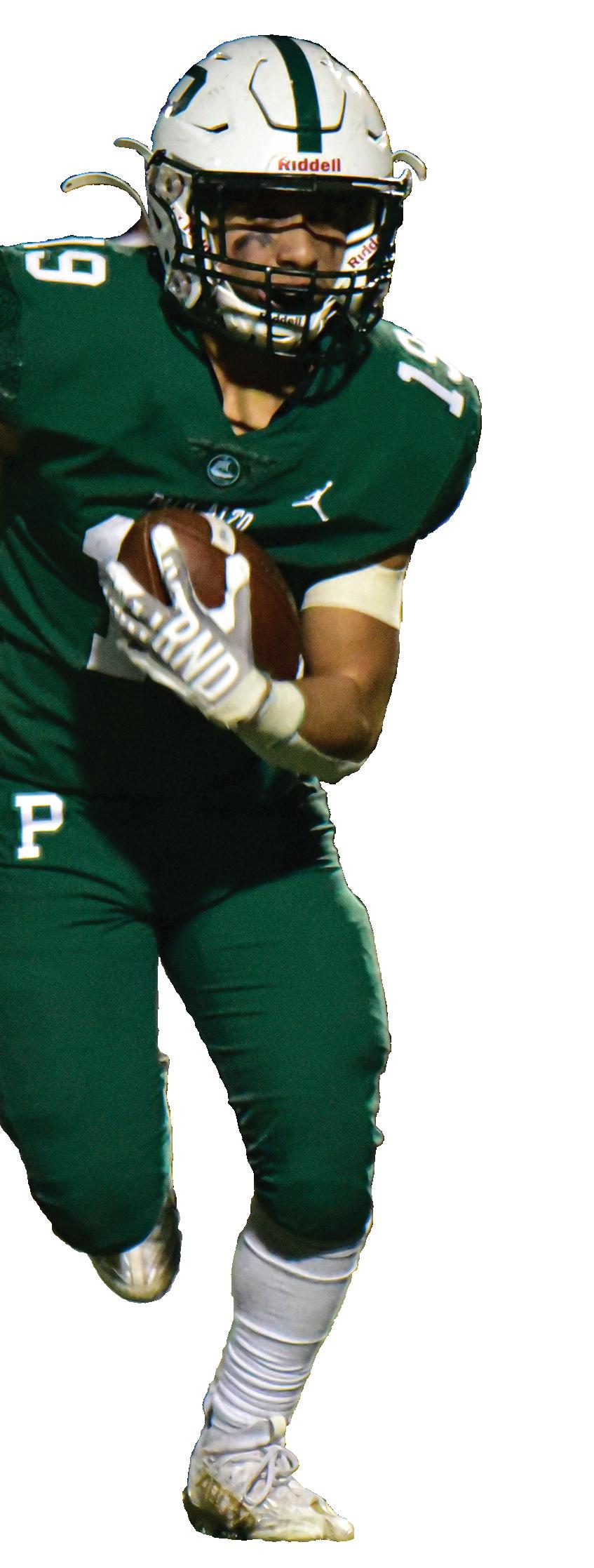
ere is no current rationale within Ed Council for using both F/NM given the inconsistencies around the data when disaggregated by race. We will revisit this conversation in future Ed Council meetings to determine next steps for eliminating the disparities seen in last year’s data,” the report said.
In addition to support systems for students with Ds and Fs, DiBrienza said another way to make grading practices more e cient is to increase transparency around the use of soft skills in grades. To make grading clearer, DiBrienza said schools should move towards standardsbased grading.
In an e ort to expand its reach into the Belmont area, Stanford University submitted a proposal to purchase 46 acres of Notre Dame de Namur University’s campus in early October.
Joel Berman, Director of Community Engagement and Communications for the Stanford/Belmont Project Team, said Stanford entered into an option-to-purchase agreement with NDNU in September of 2021.
e agreement provides Stanford with an option to purchase the property by mid-2025,” Berman said. “Should Stanford ultimately acquire the campus, it will make decisions about speci c academic uses and submit detailed and phased development plans to the city. NDNU and Stanford will remain separate academic institutions.”
According to an announcement published by Provost Persis Drell in October, “Establishing a Stanford Belmont campus presents exciting potential opportunities for our educational mission as we pursue the university’s Long-Range Vision that includes more purposeful engagement with the region. As I walked around the campus, I was inspired by its beauty, history and place in the community and the many possibilities it holds for learning and community engagement.”
Berman said the NDNU property is perfect for Stanford’s vision because of its already existing amenities.
“ e property’s existing use as a residential academic campus was an important consideration for Stanford, as was its location on the Peninsula, in proximity to public transit and the university’s existing Stanford and Redwood City campuses,” Berman said.
According to a San Francisco Chronicle story, Stanford “envisions adding up to 200 units of housing and 1,350 parking spaces for students, faculty and sta and buildings for education and community programs.”
While Stanford continues to be a prominent in uence in the Palo Alto community, few Paly students said they are a ected by the expansion.
Senior Partha Krishna, a Stanford applicant, said he was not surprised by the expansion.
“ is doesn’t really change my view on Stanford,” Krishna said.
“I knew Stanford owned a lot of land around the Bay Area and that they were continuing to purchase land, so it seems like more of the same to me.”
However, senior and Stanford applicant Jonas Pao said the expansion seems bene cial because it might mean more students will be admitted.
“I think this makes me like the college a bit more,” Pao said. “ e applicant pool for all schools has been getting really competitive over the past couple of years, which might be due to greater accessibility of things like the Common App or education as a whole. is is obviously a good trend, but it does make me
and a lot of others pretty nervous about the entire application process, so I think expanding campus does ease my nerves a bit.”
Pao said the expansion can also mean more admissions.
“ e increase in competitive college applicants is a result of an increase in accessibility of quality elementary to high school education, and expanding the number of students that colleges admit through building projects can allow the high volume of academic students to continue to thrive,” Pao said. “ is move is not only good for applicants, but probably also (for) the school, as the higher volume of students will bring in more talent to Palo Alto and the university, so I see this as a win-win.”
But Krishna said while an expansion into Belmont may add another spot for Stanford students to gather, the distance makes it unrealistic for students to gather in that speci c location.
“I think the expansion area is too far from the main campus to provide a new area for community bonding and meetups,” he said.

Pao agreed and said he doesn’t see the expansion helping Stanford’s community aspect.
“Obviously, I am not a Stanford Student, so I don’t really know how this would change things, but I would guess that student unity might take a hit,” Pao said. “With housing getting more spread out, it might be harder for people across campuses to collaborate and hang out, but that is just me guessing.”
Lillian Clark Lifestyle, Sci/Tech Editor Julian Hong Guest Writere resignation of the Board president and a controversy surrounding open forum speaking time highlighted the Nov. 15 Board of Education meeting.
First elected in 2014, President Ken Dauber o cially resigned after eight years of service. Dauber has been an advocate for student mental health support and helped oversee the implementation of the Wellness Centers at Paly and Gunn and the curtailing of zero-period classes.
Many attendees at the meeting said Dauber’s legacy is one of success and action.
“One of the main things you taught me was how to get things done,” Vice President Jennifer DiBrienza said.
Over 45 minutes, Dauber’s accomplishments were celebrated by over 15 di erent community members.
During the meeting, the Board also voted 3-2 to reduce open forum speaking time to two minutes. Open forum is time allocated to the general public to comment on matters to the Board. rough Zoom or in-person, the speakers used to have three minutes to address the Board.
DiBrienza, Board member Jesse Ladomirak and both student representatives opposed the resolution.
“I can understand where the Board is coming from,” Paly Board Representative Johannah Seah said. “But I think what makes it di cult is that it does deter students from coming to speak. It’s already the case that many do not come to meetings.”
Ladomirak said she thinks more public participation at Board meetings is better for the Board.
“I believe our past practice, which started at three minutes and decreased from there when a large number of community members wanted to speak to a speci c item, struck the right balance. I saw no compelling reason to change it,” she said.
Despite voting against the change, Ladomirak said the new policy shouldn’t impact the number of people who can comment at meetings, and many speakers currently don’t use their full three minutes.
Ladomirak said, “ ose who do have a lot to say will need to do so more e ciently, and, of course, are always encouraged to email their thoughts in writing to board@pausd.org.”
Continued from A1 “ e bene t of evidence-based grading is that teachers make clear what their expectations are before assessments,” DiBrienza said. “I think everyone agrees that mapping a four to an A and a three to a B or C is not really helpful.”
Ladomirak said variances in grading practices between teachers in the same course can also lead to unfair outcomes for students.
“(Students) should be graded the same no matter which teacher it is or which school they’re at,” Ladomirak said. “And the frustrating thing for students is it’s all showing up the same on the transcript. We don’t know that if you’re in a certain teacher’s class, you’re more likely to get an A than if you’re in a di erent teacher’s class.”
Ladomirak said along with family, teacher, counselor and site council engagement, student input is crucial for the Board’s next steps.
“ e annual and biannual Panorama and California Healthy Kids surveys are de nitely something we look at very closely at the board level,” Ladomirak said.
Ladomirak also said she hopes the district can incorporate more student voices.
“I would love some infrastructure in place in our district where student voice is more systematized,” Ladomirak said. “It should be a place where their voices will be heard and they know the person representing them is going to work hard to bring diverse viewpoints.”
DiBrienza said while removing biases in schools will be di cult, PAUSD is currently implementing fairer practices for its students.
“Every school district in America and just about every system in America probably has biases in some ways,” DiBrienza said. “We happen to be a community that has funding that we can put towards these initiatives, and we have a highly educated and engaged population of community members, families and parents. So if anyone can do it, I’d like to think we can.”
With a $2 million grant from the Santa Clara Valley Transportation Authority, Palo Alto has announced plans to implement a new on-demand shuttle service in spring 2023 after the previous system was discontinued in 2020.
Transportation manager Sylvia Star-Lack said the new transit service will replace the previous shuttle, which shut down after facing funding challenges and a rise in COVID-19 cases.
“Instead of having a xed route with regular stops, this (shuttle system) will be more similar to Uber or Lyft where people will open the app and make requests,” Star-Lack said. “For the service, we’ll have nine vehicles in the eet serving internal Palo Alto trips that will go across the city.”
Star-Lack also said the shuttle will go almost everywhere in the city except for some remote locations like Foothill Park and the Baylands.
“It’s going to stay where most of the development is in town,” she said.
Transportation manager Nathan Baird said many residents felt the impact of losing the previous shuttles.
“I think we’ll broaden (transportation options) to not just bring back the shuttle but bring it back with additional utility,” Baird said. “It’s great that folks will have more options when they’re thinking about (taking) those types of trips.”
Star-Lack said the app’s computer algorithm will group people with similar destinations to optimize the shuttle’s routes. Users will also have the option to request a ride through an app or make a phone call.
“People who are going to either get picked up in (or go to) the same place will generally be in the same car,” Star-Lack said. “( e computer algorithm) will try to optimize the origins and destinations, kind of like an airport shuttle.”
To maximize e ciency, Star-Lack said riders may have to walk a short distance for some trips, but the shuttle will also provide accommodations.
ere will be an option for people who need (direct) accessibility to have door-to-
door services,” Star-Lack said. “We will also have a few vehicles with wheelchair access for folks who need to bring their wheelchairs with them.”
Junior Chista Irani said the new shuttle service will be a better alternative to Uber and Lyft, which she said are expensive.
“ e fare for the shuttle makes it a more a ordable option for residents,” Irani said. “I think a lot of people will look into this option.”
Star-Lack also said there will be opportunities to designate key destinations based on the most frequent requests such as downtown or the Caltrain station where people can be picked up or dropped o . According to StarLack, this service will bene t a broader range of people due to its low fares.
“High school students will be able to utilize the shuttle and take it to other locations in town,” Star-Lack said. “ e fare is $1 for
students, $1 for seniors and the full fare is $3.50.”
Another advantage of the shuttles is that some of them will be environmentally friendly.

“A few of them will be plug-in electric or electric hybrid vehicles,” Baird said. “We are also requiring the service provider to provide bike racks on the vehicles.”
And Star-Lack said the service will be particularly bene cial for people who can’t drive.
“Arranging rides for people who can’t drive, who need to go to the doctor or who have an essential need to go to the grocery store will be very helpful,” Star-Lack said. “It’s really important for them.”
In
response to declining student enroll-
ment, Fletcher Middle School plans to implement a sustainability theme into its curriculum and allow PAUSD middle school students outside of Fletcher’s attendance boundaries to enroll next year.
Seventh and eighth grade Fletcher science teacher Tamara Wallace proposed the program during the Board of Education’s Oct. 25 meeting.
“Fletcher’s Sustainability for All program creates opportunities for students to explore ways they can take equitable action to promote a ourishing environment in which people and living things access healthy food, clean air, and safe water,” Wallace said.
As a themed school, Fletcher will embed a focus on environmental sustainability in its core classes.
Board member Jennifer DiBrienza said all students will participate in environmentallyconscious work.
“ e entire school is going to do some of this sustainability work,” DiBrienza said. “If you’re zoned for Fletcher, your science classes are probably going to have more sustainability topics. You’ll see students doing gardening work, or writing or researching in their humanities classes about sustainability and about climate change.”
To increase its outreach, the middle school will also partner with various community organizations including Stanford’s Doerr School of Sustainability.
“ e city continues to move towards its sustainability goals, and Stanford just recently opened a new School of Sustainability,” DiBrienza said. “ ose are going to be two partners for Fletcher.”
DiBrienza said the program was created to counter Fletcher’s declining student population.
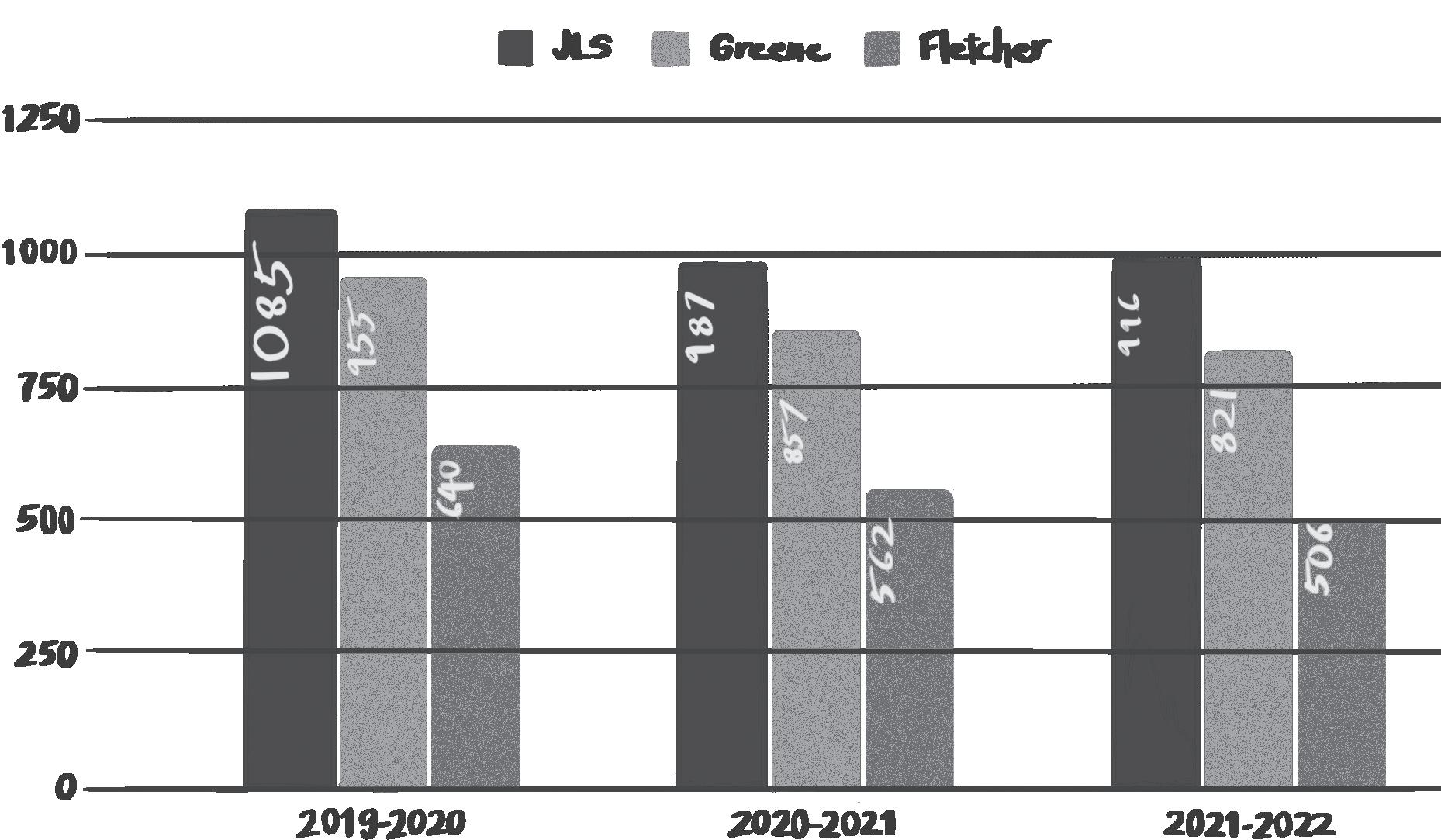
While the school can support around 750 students, it has fewer than 550.
“Fletcher was always been our smallest middle school, but as enrollment goes down across the whole district, enrollment is going down at each of our schools,” DiBrienza said.
“Because Fletcher was already a smaller school, enrollment went down precariously.”
In comparison to Fletcher’s intention to increase student enrollment, DiBrienza said the two other middle schools in the district have themes that were introduced as an alternative to traditional learning opportunities.
e (JLS) Connections program probably was our rst specialty middle school,” DiBrienza said. “Parents were working to o er a more project-based alternative to the mainstream experience. e only other middle
school choice we have right now is the language bridges programs (at Greene).”
e choice aspect of Fletcher’s sustainability program will be a lottery system that will allow students living in the other middle school boundaries to attend Fletcher instead.
Board member Jesse Ladomirak said the proposed program is something that could be implemented across the district.
“Even if JLS is your neighborhood school, you still have to apply to get into the Connections program,” Ladomirak said. “With
Jung Sta WriterWith the highest hospitalization rates in over a decade, this year’s u season could be one of the worst on record. Forty-four states already have more infections than in the week before, and the Centers for Disease Control said 3-11% of the population will be infected this year. On top of that, COVID-19 infection rates are increasing week to week.
However, as exams and end-ofsemester deadlines approach, some students are risking the spread of the virus to attend classes to stay on top of their work.
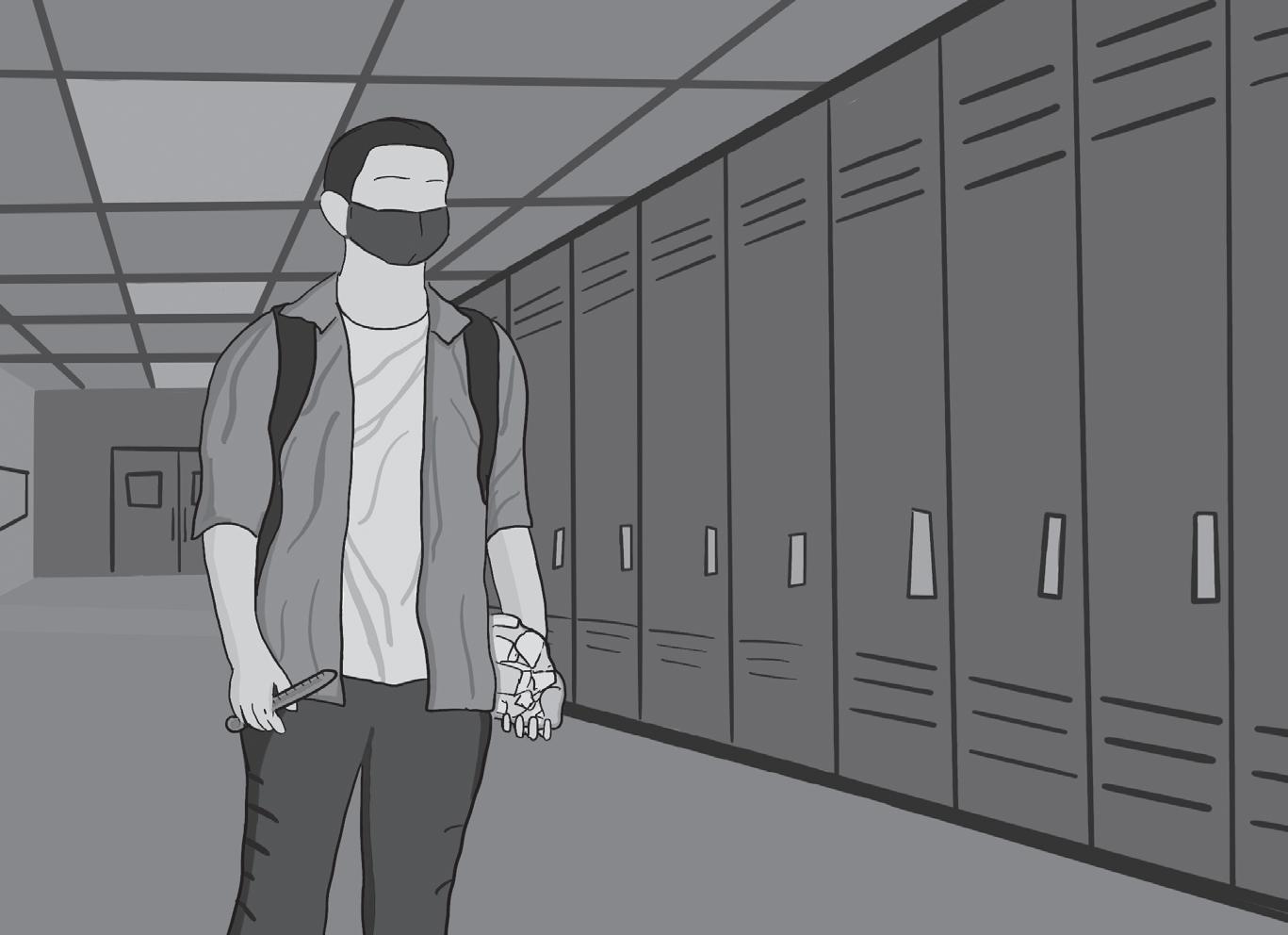
Intro to Analysis & Calculus teacher Zachary Barnes said students should not come to school when experiencing symptoms.
e annual Sports Boosters Christmas trees sale began the weekend after anksgiving in the corner of the Tower Building parking lot.
e sale is a fundraiser for the Boosters and Paly’s athletic programs.
Christine, a Paly parent who bought a tree at the sale, said she likes that the money from the sale goes to the athletics program.
“It was pricier than I was expecting, but I liked that it’s from the Paly lot,” she said.
Volunteers for the lot worked rain or shine.
“We were here when it was raining because it’s for Paly athletics,” senior and volunteer eresa Hart said. “It’s for our sports teams.”
However, rain, re and drought all contributed to fewer trees for sale this year.
Former Sports Boosters president and event volunteer Kristen Andersen said the supply of trees was cut short due to natural disasters earlier this year.
“We got short-shipped because they lost about a third of the crop in Southern Oregon last year during the res and the drought,” Andersen said.
“When the truck arrived, we were missing all of our tall trees.”
Despite the smaller supply, Anderson said the sale should still be a success because of presales.
“Almost half our stock were presales,” Andersen said. “By the end of the weekend, we’ll have sold close to 300 (trees).”
Andersen also said the Holiday Tree Lot is a community bonding event where alumni return to support the school.
“We see a lot of alumni families coming back to get their trees,” Andersen said. “You see a lot of families you get to know come back year after year.”
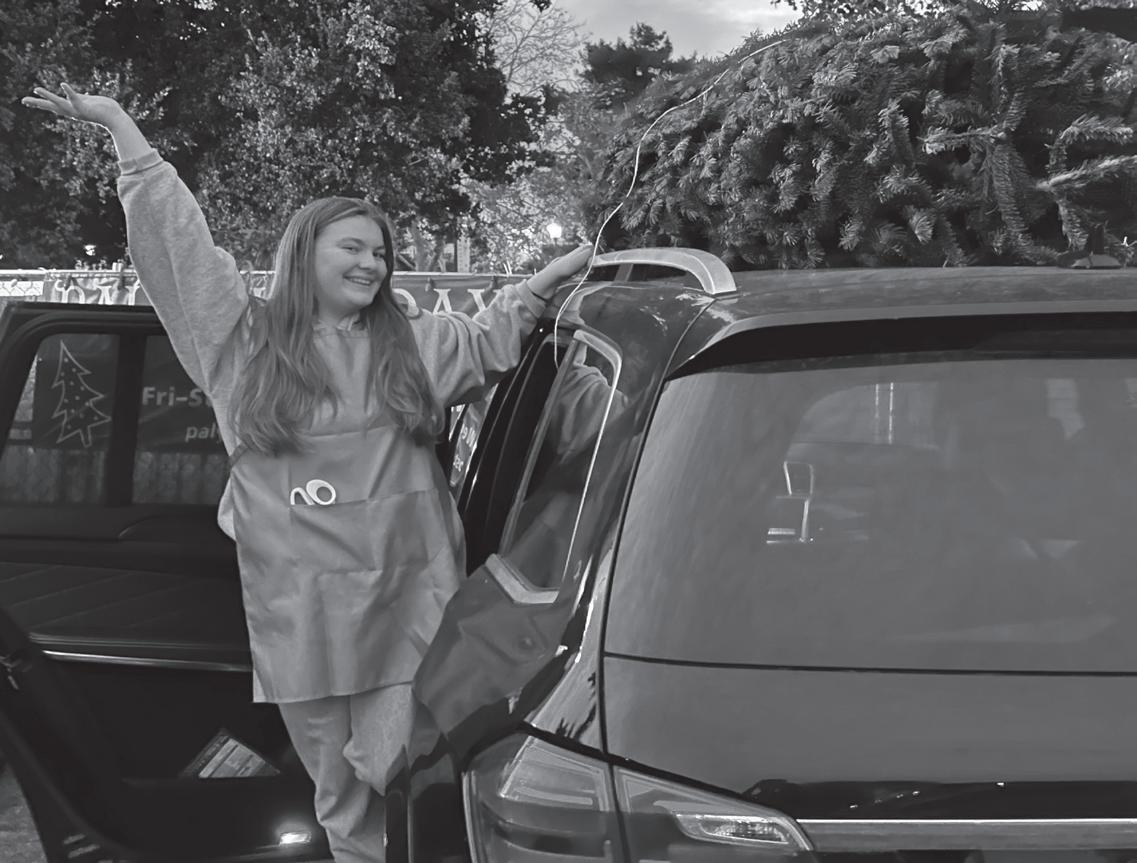
And Christine said the cost of a real tree is worth whatever she has to pay.“It’s a bit of a struggle because a lot of people are moving to synthetics, and I understand their rationale,” Christine said. “But I just love the idea of another living thing in the house.”
e o cial sale ended on Dec. 6, but Andersen said Sports Boosters may sell the leftover trees on a case-by-case basis.
“We’ll open up by appointment to sell the remaining trees and then also take donations,” Andersen said. “We then take the extra trees that we have, and we give them to good causes.”
“I think we at Paly sometimes forget that we have an obligation to keep each other well,” Barnes said. “If students are sick, they should stay home because I can’t tell if it’s their allergies or not, and I don’t usually see it as ethical to point at someone and tell them they should go home.”
Barnes said students should care for themselves and other students by utilizing online resources at home when sick.
“We provide all the work on Schoology and granted, being at home, you’re not going to learn as well as being in school, but you can still catch up,” Barnes said. “It’s a sel sh thought to come to school knowingly sick when they should be protecting themselves and others.”
For senior Jennifer Mori, deciding whether or not to come to school when she is sick depends on the severity of the illness.
“If you know that you’re actively sick and contagious with the u, you should de nitely stay home,” Mori said. “But if it’s not very harmful and you wear a mask, it can be OK.”
Mori said missing school and needing to catch up on work while other
Ti any He News/Opinion Editorclasses are still progressing motivates her to avoid skipping classes.
“In general, emailing teachers to get caught up on all that work takes a lot of e ort and time that otherwise could have been avoided by simply going to school,” she said.
ough online learning is an option for sick students, Mori said many students are less inclined to nish assignments without help from teachers.
“Even if it’s online resources, you don’t get the same kind of support from teachers and other students that you would get learning in class,” Mori said. “To be honest, there are many teachers that only (post) assignments on Schoology without proper context and lessons for students to work with if they were not in class for it.”
Junior Morris Tang said academic pressure also drives students to sacri ce their health and the safety of others to come to school sick.
“It is a Paly tradition here; people don’t want to be behind, and even if they are a little sick, they don’t care about it as much,” Tang said. “It isn’t their main priority. ey (want) to be present at school whenever they can to get the materials they need to avoid
any chance of unking a test or not understanding a lecture.”
AP English Language and Composition teacher Katie Elder said especially as the u season intensi es and the pandemic lingers, there is a need for teachers to ensure students have the materials they need to work online productively.
“It’s u season, so absences will still go up, and it’s becoming more important than ever to make sure that students can access better materials and instructions from home, especially with COVID still being around,” Elder said.
For students like Mori, reducing the competitive environment, particularly rigorous courses could in uence students to become more exible with how they value their physical health over their classes.
“I would feel more comfortable staying at home and missing school if I got sick again, especially if my harder AP classes were not as tough,” Mori said. “ e cost is pretty high to make up assignments, learn content and do the activities on your own.”
Elder said regardless of the stresses students feel to maintain high grades, she hopes everyone prioritizes their health above all.
“We, the sta , the teachers and everybody should be doing everything they can to promote being safe, because health is, or at least should be, the top priority for everyone,” Elder said. “For students, we can always get you caught up on schoolwork, but we can’t help you get better.”
This year, America had the most school shootings since rst recorded in 1970, according to the Center for Homeland Defense and Security’s school shooting database.
As the state with the highest number of school shootings since 1970, California has faced an uptick in school violence against its youth over the last 52 years.
And while Paly has never experienced a live active shooter on campus, numerous threats have compromised student safety, including dangerous people being present on campus.
ough some students say are concerned about outsiders’ uninhibited ability to enter and exit Paly’s open campus, members of PAUSD’s administration say district schools are well-prepared to handle an attack.
In 2019, PAUSD faced two threats of armed violence: a bomb threat at Paly and a shooting scare at Gunn.
ough law enforcement’s rapid response prevented escalation, the school went into code red lockdowns both times.
History teacher Adam Yonkers was in the middle of a lecture during the 2019 bomb threat and said the code red lockdown was terrifying.
“We were doing everything that we had been trained to do, which is barricade the door and hide behind (or) under desks,” Yonkers said.
Steven Gallagher, now the Director of Student Activities at Paly but then a World History and U.S. History teacher who was also teaching a class during this bomb threat, said local police response helped that day.
“In my classroom, we had everyone against the wall, (and we) put up barricaded tables, and then we were there for an hour and a half,” Gallagher said. “ at day, there was a huge police presence, and they were very well trained.”
But Yonkers said while Paly responded well to the threat, improvements to sta training could help everyone on campus feel more prepared to protect themselves in case of future incidents.
“I feel that the school has advised teachers on what to do, but in terms of the quality of the training, it’s more like a PowerPoint presentation,” Yonkers said. “I’d like to be more prepared. I know what to do, but I think (sta ) training needs to happen more than once a year.”
However, Paly is not the only PAUSD school that has faced threats.
Also in 2019, this time in September, police detectives and school resource o cers investigated a Gunn High School student who posted a comment about wanting to “shoot up” the school on Instagram. Within three hours, the police apprehended the student.
In a separate incident, on Dec. 13, 2019, another student from Gunn was taken into custody after allegedly threatening a school shooting on social media.
After receiving a tip about the rst threat that ursday night around 9 p.m., police apprehended the suspect at approximately 2:45 a.m. on Friday and increased police presence on campus that school day.
According to a Campanile survey conducted through Schoology on Dec. 1, 65.9% of students say Paly is underprepared to protect students in the event of a school shooting, citing their lack of awareness about formal safety procedures.
Mike Jacobs, PAUSD’s Safety, Security and Disaster Preparedness Manager, said that the “Run, Hide, and Fight” defense mechanism is taught to both students and sta e steps, according to the FBI, are as follows:
Run: Evacuate the area and help others escape, if possible. When safe, call 911.
Hide: Conceal yourself in an area out of the shooter’s view, making sure to lock the door nearest you or block any entry to your hiding place.





Fight: Use this as a last resort and only when your life is in imminent danger.
Regarding the procedures, junior Sarah Shea er said while she thinks administrators are doing the best they can to ensure campus safety, improvements can be made in how drills are conducted.
“(Paly) should consider (what to do) if you are on the edge of campus,” Shea er said. “If you’re right by Town and Country, maybe you should run there. Or if you’re walking through the quad, where do you go? I think they should do drills, but (also) include more situations than just counting on you being in class.”
Gallagher said plans to prepare the student body for an attack through lockdown drills are in the works but have been hard to implement for the past two years because of COVID-19 restrictions prohibiting close proximity between students.
“ ere was a very minimal lockdown drill (last year) because of COVID-19,” Gallagher said. “(Previously), there had been lockdown drills where police were present on campus, and you’re locked down. You go through all the procedures.”
Yonkers said the problem lies not with the amount or quality of procedures, but with the way they are integrated into school days.
On pre-planned days for campus-wide emergency training, Yonkers said he noticed students purposely not attending school.
To minimize student absences, Yonkers school should intersperse training throughout instead of on speci c predetermined days. ough (student absences on emergency the school’s fault, I think (Paly) has to embed average day,” Yonkers said.

Shea er, who advocates for a more in-depth, to lockdown drills, said training should be “I don’t think that the training is something planned, like ‘Oh, we are having a drill next “It should be kind of random, because that in real life.”
However, Palo Alto Police Captain James type of training schools are conducting is “I can say that I am con dent that sta the district are receiving relevant training practices and have been for more than a decade,” said. “PAUSD and the Palo Alto Police Department mitment to doing our very best to keep students Yet, junior Caiden Soltesz, who responded Schoology survey, said the problem is not school’s infrastructure.
“Paly in particular that prepared ing) because a big windows and Soltesz said. “Additionally, people who are go to, or have they’ve also done everyone else.” Soltesz said the district should armed police to Some districts the Fremont and School Districts, called safety resource o cers, currently employed “Getting the police on campus as fast as them engage the shooter (is the main goal),” an o cer on campus shortens the response Jacobs said that due to COVID nancial have SROs on campus.
“Following COVID-19, the city made and the number of SROs decreased,” Jacobs not continue its relationship with the SRO ough armed o cers may not be in PAUSD’s said the district is planning on making other campus security at both Paly and Gunn.
“Within the last two years, we have added points at all campuses,” Jacobs said. “We are systems and phones. Both phone and intercom to easily activate the ‘Run, Hide, and Fight’ recorded message (and) also allows us to pinpoint potential threat.”
According to David Studdert, a Stanford in gun policies and violence, the presence primary contributor to school shootings.
“One of the common themes in active ing young people is that the guns often come home, and so if there aren’t guns there in duces the risks that (a school shooting) can e FBI also says easy access to weapons risk factor for school shootings, according by the Supervisory Special Agent Mary Ellen e family keeps guns or other weapons in the home, accessible to the student,” the normal safety precautions), parents or a signi handle weapons casually or recklessly and to children that a weapon can be a useful intimidating someone else or settling a dispute.”
Studdert said America’s high rate of household increases rates of violence.
“About one in three households in the one rearm unit,” Studdert said. “We know home are associated with higher risks of death
Yonkers said he thinks the throughout the school year days. emergency training days) are not embed (training) more on an in-depth, holistic approach be more spontaneous. something that should be next week.’” Shea er said. that is how it’s going to be
James Reifschneider said the intentional and accurate. at Paly and throughout based on industry best decade,” Reifschneider Department share a comstudents and faculty safe.” responded to e Campanile preparedness but the particular is not really all to handle (a school shootlot of classrooms (have) and multiple entrances,” “Additionally, most of the are shooting up schools gone to that school, so done the same drills as else.” said to protect the school, should consider investing in to patrol the campus. districts in the Bay Area, like and Berkeley Uni ed Districts, have armed o cers, employed on campus. as possible and having goal),” Soltesz said. “Having response time greatly.” nancial restraints, Paly will not changes in its budget, Jacobs said. “ e district did SRO program (since).” PAUSD’s plans, Jacobs other improvements to added cameras to entry are adding new intercom intercom systems allow us Fight’ protocol with a prepinpoint the location of a


Stanford professor specializing of guns in homes is a shooter incidents involvcome from the family the family home, it recan happen,” Studdert said. weapons is the most signi cant to their report published Ellen O’Toole, Ph.D. weapons or explosive materials the report said. “(Without signi cant role model may in doing so may convey and normal means of dispute.”
household gun possession
United States has at least know that rearms in the death and injury by guns.”
However, according to the Bureau of Firearms, California has one of the strictest gun policies in the country and regulates who can own guns and what types of rearms people are allowed to buy. Additionally, the CDC lists California as the 44th lowest state in the nation regarding the rate of deaths by gun violence.
Furthermore, a study conducted by Stephanie Chao M.D., Assistant Professor of Surgery at Stanford, and a team of students at the Stanford School of Medicine found a correlation between states with stricter gun laws and reduced gun-related casualties.
“If you put more regulations on rearms, it does make a di erence,” Chao said. “It does end up saving children’s lives.”

According to the American Psychological Association, while there is no clear link between mental illness and violence, strong mental health resources are vital to prevent violent behaviors from escalating.

ese resources include risk assessments and suicide prevention resources.

In addition, the National Education Association says a lack of mental health resources is often the root cause of many school shootings.
“Having good counseling services and regular contact with students, especially those that are struggling, is super important,” Studdert said. “Having an ability for students to access mental health services and counseling when they need it is also (really) important.”
Studdert also said students planning to conduct a school shooting often exhibit unnatural signs of distress.
In order to prevent problems from escalating, people who notice these di erences in behavior should take immediate action.
“Another thing that’s really important is to try to identify people who are in a crisis and intervene to help,” Studdert said. “So seeing those signs, whether it’s fellow students or teachers or family members, and getting help can help to avert school shootings before they happen.”

According to the FBI, visible signs of distress include subtle threats, boasts, innuendos, predictions or ultimatums regarding violence.
ey also cite “leakage,” or a person’s communication to a third party of an intent to do harm to a target, as a sign of concerning behavior.



“‘Leakage’ occurs when a student intentionally or unintentionally reveals clues to feelings, thoughts, fantasies, attitudes, or intentions that may signal an impending violent act,” the FBI database said. “Leakage can be a cry for help, a sign of inner con ict or boasts that may look empty but actually express a serious threat.”
Reifschneider said strong mental health structures can aid in preventing active shooter incidents from happening.
“Early intervention, before any violence occurs, is always the best outcome,” Reifschneider said. “Anyone observing concerning behavior should promptly contact police and school sta .”

Empty cups of co ee lay on desks surround by college essay books, the so-called key to admissions. As seniors struggle to summarize their achievements from their 17 years or so of existence in 1,000 words, they all hope for the best.
Behind the impressive statistics and stellar achievements, a vast majority of seniors have utilized outside resources to gain a leg up in an increasingly competitive college admission system. College counselors, experts in navigating the complicated and stressful college application process, are often perceived as a way students can improve their chances at admission.
But the investment in these college counselors, especially in the Bay Area, can range from a couple of thousand dollars to over $60,000 — equivalent to a year of college tuition. So are college counselors really worth their price tag?
As a student who’s explored many aspects of the high school experience including searching for a college counselor, the answer is yes. However, the answer truly depends on when you begin your journey with a college counselor and what you hope to gain from the guidance.
e college application process can be broken down into two main portions, the pre-college resume-building, and the actual application.
Many mainstream college counseling programs such as FLEX College Prep start preparing their students for the college application process before students start high school, sometimes as early as 7th grade. By starting at such a young age, students can learn to participate in activities that may help their future applications.

College counselors also give bene cial advice on ways to increase outreach opportunities by helping students discover extracurriculars that interest them.
However, if a college counselor starts this process before a student knows what they are interested in, it might not be worth the investment since students have several more years to decide where their interests lie.
When we change to consider juniors and sophomores in high school, that’s when having a college counselor might become bene cial. By this point in a student’s academic and social life, many have started to understand what they are interested in and what major they may want to pursue.
is is when a college counselor’s pre-essay process may be the most helpful in providing students with opportunities to strengthen their applications, whether through summer program suggestions, connections, internships and more.
Starting this resume-building process during a student’s mid-high school years can be the most rewarding in terms of how much is invested in a counselor and the return on that investment. While starting early seems to be the norm in a uent cities such as Palo Alto, the reality is that a college counselor becomes more helpful in the later years of a student’s life, especially in the essay writing portion of junior and senior year.
With students applying to multiple colleges, the number of essays a student needs to write piles up.
is type of writing process is what college counselors truly specialize in.
A typical essay question asked is ‘What is an obstacle you faced in your life, and how did you overcome that?’

When students rst see this question, they often don’t know where to start because picking a speci c moment from all their high school memories is di cult.
A college counselor, who has years of experience watching trends in college admissions, is particularly helpful in guiding you on how to craft an essay that is captivating to an admissions board.
Of course, college counselors can’t guarantee a student’s admission, and they do cost a lot.
But while a college counselor cannot make or break a student’s application, they can help students package themselves and stand out from a sea of other highly quali ed applicants.
Deshpande Sports Editor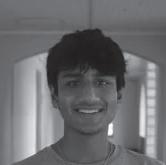
“Test grades are out.” is was the text I’d been dreading since last week. I nervously opened the Schoology app to see how well I did.
A 78% stared back at me.
e next day, I stumbled into class, wondering how I got a C on the test after thinking I aced it.
It got worse when I got the test back because I was stumped by the rst problem I got wrong.
As I struggled to gure out what I did wrong, the teacher’s alarm let out a startling ring. It was time to return the tests (no pictures or writing down questions), and I only got through two of my errors.

When I got home, I realized that rst, I suck at solving pulley problems, and second, I don’t know how to improve in the class. ere were speci c questions on the test that involved multiple concepts, and while I understood the concepts individually, I couldn’t put them together. And without access to my test, I can’t learn from the mistakes I made.
While a test assesses your pro ciency in a subject, the important part, where the learning happens, occurs only after it’s graded.
Harvard Business Education suggests that teachers “o er students the opportunity to self-correct their answers after the quiz rather than giving them immediate feedback.”
And according to research by Vanderbilt, delayed feedback — thorough feedback given over time after an assignment is nished — translates to better retention and learning than the brief and immediate feedback I was given in class.
Only when students are given time with tests to self-study can they see the mistakes they made, understand the types of errors they’re prone to and practice until they get the material down.
When teachers don’t let students keep tests, students don’t get the opportunity to do thorough learning, defeating the larger purpose of testing.
Why do teachers make students return tests? A lot of it has to do with them wanting to reuse tests, and allowing students to keep tests would invariably result in cheating in future years.
is is why taking pictures of the test or writing down questions is not allowed: those pictures or questions could be given to siblings or friends who are taking the class in the future, leading to academic dishonesty.

But would it be that di cult for teachers to swap some numbers, change the questions to test slightly di erent erent types of problems
Most classes only have a few tests per semester, so changing up tests once every year can’t be that hard, and it’s worth it when you consider the erence it makes in learning for students to have access to these
All teachers should give their tests back to students once they are graded so students can look through them as frequently as necessary to understand mistakes and retain information.
e learning that happens after the test is just as important as the learning that leads up to it, and letting students keep their own tests allows that crucial learning to happen.
Jung Sta WriterWhen I look around the campus after lunch, I always see half- nished school lunches on ketchup-stained tables and random bruised apples rolling around the quad, scattered within the fall leaves.
ere is also plenty of litter on the concrete, and random, di ering trash around bins where they shouldn’t be in.
Students seem to regularly disregard rules about disposing of their trash, and there seems to be little administrative enforcement of trash clean-up policies.
Our custodians have enough responsibilities without having to pick up trash. What we need is stricter, better-enforced trash policies.
e current trash policy is that school o cials expect students to pick up their trash and put it in the right bins to keep the school pristine.
But this is an unspoken, moral rule that many students ignore.
roughout elementary and middle school, we are taught to properly dispose of our trash by yard duty volunteers, teachers and student-led committees that stress the importance of good trash policies.
But now, in high school, adults assume we are responsible enough to do the right thing and the trash rules are much more loosely enforced.
In my three years at Paly, I have only seen a couple of teachers and Principal Brent Kline attempting to enforce trash policies, but there is a clear lack of oversight in reminding students to be more responsible when it comes to keeping the campus litter-free.
Evidenced by the litter scattered around campus after lunch, however, high schoolers have yet to demonstrate that they are capable of proper clean-up.
Part of this comes from the fact that our student body is mostly privileged, which often brings a mindset that makes students think it is OK to leave out garbage because someone else is paid to clean it up later.
But this upperclass privilege and ignorant mindset should not be an excuse to disregard the importance
WANGEspecially in the cut-throat competition of the Bay Area, not having a college counselor can be a disadvantage.
Ultimately, college counselors can be worth the investment.
As students approach the daunting task of applying to a college or university, many will rely on a college counselor to help them stand out from the crowd in the ever-competitive college admission process.
Tanaka Guest Writer
of maintaining a clean campus, as it is a general obligation of the public to clean up after themselves.
is mindset also leaves little room for helping custodians and leads to a lack of accountability. In addition to students’ privileged selfperceptions and a lax enforcement of policy, the school has insu cient trash bins on campus.
e few available are often far away from each other and constantly changing in location.
Not only are they far apart and hard to nd, the three main types of bins — recycling, compost, and trash — are usually separated across campus instead of being grouped together.
To avoid constantly seeing wind-scattered pieces of trash, there is a clear need for more trash cans on campus and to have three types of trash cans in one place and reduce the inconvenience of throwing trash away for students.

is would reduce the amount of litter on the ground and reduce the time-consuming and tiring search for a place to put garbage.
Although more trash cans means more trash bags and thus more plastic waste, trash left around campus would be reduced, and students would have an easier time nding proper waste disposal.
Administrators should also hold students more accountable for picking up their mess by dedicating times on teaching how to properly throw away the trash.
If the right steps are taken to properly enforce and motivate students to make a cleaner campus, the constant sight of dirty garbage skidding across the asphalt during lunch will become a memory forgotten and make Paly’s campus as outstanding as its reputation.
Iturn into a dimly lit, narrow alleyway where rows of apartments, stained cement and a smoky scent greet me. I pivot, asking my mom whether we are still heading in the right direction. She nods.
Two minutes later, we reach a tiny restaurant, lled with golden light and chattering families. With a clear view into the kitchen, I can see chefs bustling about, and waiters swooping in to collect and distribute dishes.
After sitting down, we’re handed laminated paper menus lled with ai script and photos of big platters full to the brim with steaming vegetables and fried sh. When the food arrived, the dishes were not only delicious, but they were also authentic.
When I say authentic, I don’t mean a typical restaurant which serves tasty food, constantly packed with families on a Friday night. To me, authentic means a local and usually small restaurant run by people who grew up around the cuisine they serve.
Furthermore, authentic restaurants are often located in ethnic neighborhoods, and the price of the food is not expensive. While it might take longer to search on Yelp for authenticity, the experience is worth it.
Eating at authentic restaurants is a winwin for both the customers and the restaurant because customers get to experience a di erent culture while supporting the families who run
When my family travels, we spend time scoping neighborhoods for authentic restaurants to steer clear of tourist traps. By spending the majority of my time in smaller, more ethnic neighborhoods where people of the same culture live in close proximity to each other, I learn more about the people in that area.
For instance, when I went to Barcelona, I spent a large chunk of my time discovering hidden Spanish restaurants, art galleries and boutiques. However, I also spent a small amount of time in an Italian neighborhood close to where I was staying. While the Italian food I ate was not typical Spanish food, it was authentic because I dined at a local restaurant owned and operated by an Italian immigrant family.
When people eat at authentic restaurants, they are often eating traditional recipes that were passed down from one generation to another. Sometimes, restaurants must alter the traditional recipe due to a lack of unique ingredients, or to produce a greater quantity of a dish. While these alterations might not give customers an identical experience as being in a di erent country, the history, lifestyle and values represented in the dishes being served remain the same. Customers not only have the opportunity to try distinctive avors, they also have the opportunity to learn about the culture of the cuisine they are eating.
Eating at authentic restaurants can also reduce one’s environmental impact by
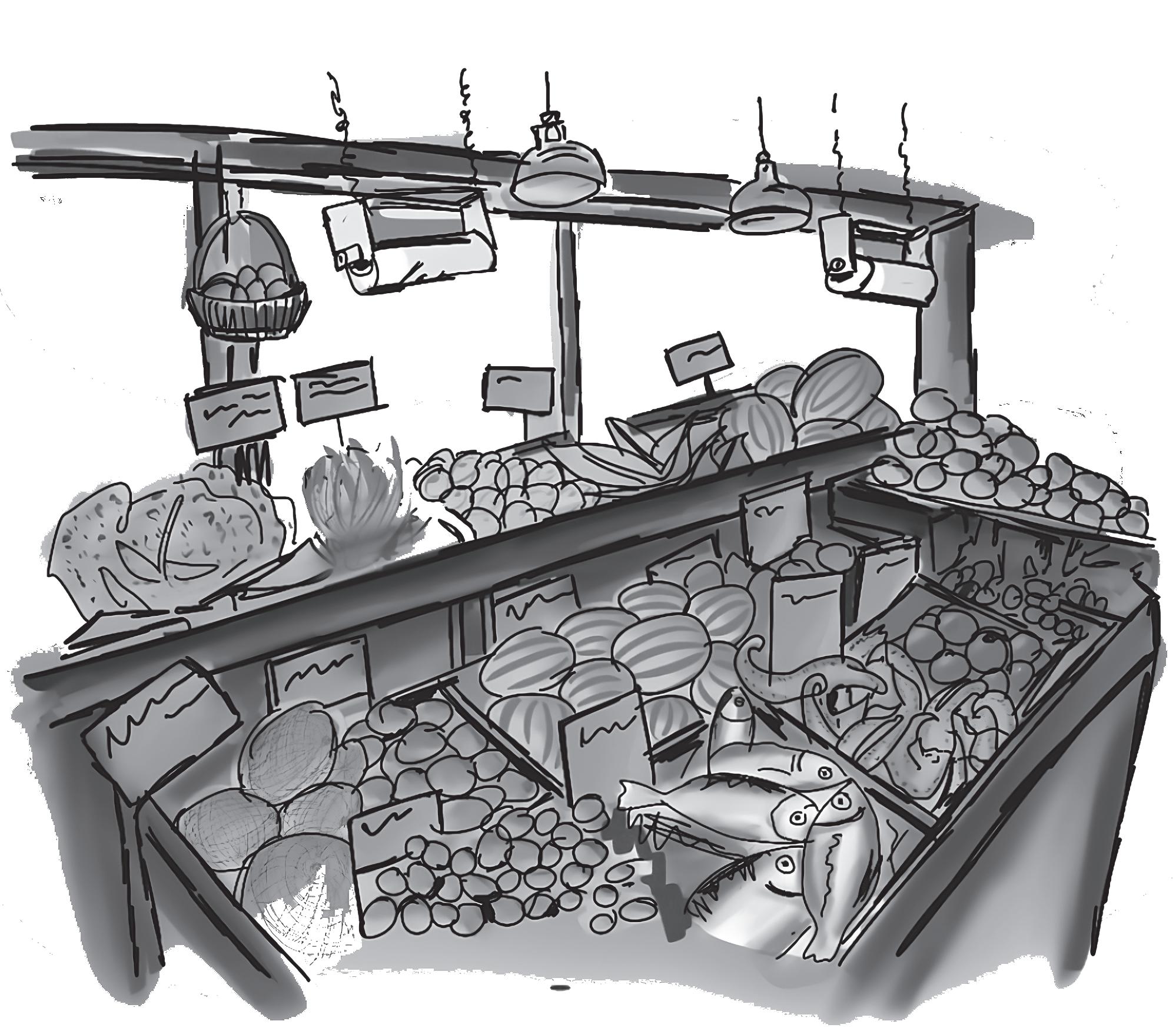
authentic restaurants are typically local, one can decrease the distance they travel, which would decrease carbon emissions.
Some people might say it is too much work to nd authentic restaurants near them, or that the food is only for adventurous eaters. Initially, it may take an extra 10 minutes searching for the perfect place, but once you’ve started seeking authenticity, you most likely won’t resort back to eating at Americanized restaurants with duped dishes.
Picky eaters might say they are afraid to try authentic dishes because of the unfamiliar ingredients. However, without trying, these people will never experience anything new, let alone try an authentic ethnic dish. By not trying new foods, picky eaters are not opening their eyes to cultural diversity.
Seeking out and eating at authentic restaurants can open everyone up to new cultures, as well as minimize environmental impact. So, instead of eating at an overpriced, American chain on your next meal out, nd a restaurant that specializes in a cuisine you are interested in learning about.
Singer News/Opinion EditorAs I hurried to school, sweat beaded down my forehead. I quickly parked my bike in the cage, realizing I only had one minute before rst period. In my rush, I left my bike unlocked, hoping to lock it later at brunch. at afternoon, I had a tennis game and was being driven there by my mom, so I completely forgot about my bike in the cage. e next morning, I was dropped o at school. I intended to bike back home. But when I looked into the cage, my heart sank — my bike was gone.
I frantically searched the area, but it was nowhere to be found. I couldn’t believe someone had taken my bike.
I was devastated, unsure of what to do next. How was I going to get home?
And what if I never saw my bike again? ese thoughts raced through my mind as I stood there, feeling helpless and frustrated. Even though I admit this was my fault, many bikes get stolen each week, and Paly must invest in more security for our bike
cages. For example, we should have some sort of closing door at night, so that people can’t lurk around cages late at night to steal bikes forgotten at school. e ideal security system would make it so you’d have to have an ID card to open the gate on all bike cages.
When I asked an administrator to check the footage to see what happened to my bike, the blurry security footage showed a man in the middle of the night who pranced in and out of the cage with my bike. e administrator told me nothing could be done to catch this man, and they told me he often comes at night to check the cages for potential bikes to steal, and he had stolen mine.
I was so desperate to get my bike back that my dad and I constantly checked online marketplaces to see if the thief would sell my bike there. Another friend of mine, whose bike had been stolen in middle school, got his bike back by buying it back from the thief.
Even if my bike had been locked, I only had a worn-down cable lock, which I had been using since at least the start of middle school. e administrator told me that even if I had used my measly cable lock, the thief would have simply cut it with a

wire cutter. One of the best steps students can take is getting a U-lock: one of those tough metal locks with a passcode. Impossible to cut.
I also believe that the administrators should help us come up with some sort of more secure bike cage. Perhaps they could use some funds to help improve the autonomous system (cameras) and help our campus be more secure from theft.
Additionally, the footage on the security camera footage was so blurry that it was impossible to identify the thief. As far back as middle school, the teach ers who led orientation told us to never trust the camera at the bike cage because, if someone stole it, the thief would be unrecognizable. Why can’t PAUSD invest in some sort of security system which can detect and deter thieves when they steal our bikes?
Bike thefts are commonplace in Palo Alto, so you would think Paly would invest in higher quality cameras, motion sens ing lights or perhaps some use of school IDs to open the gates to the cage. Additionally, if Paly took these
Hong Lifestyle, Sci/Tech Editor
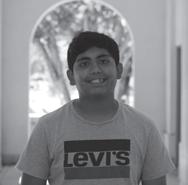


I’m usually one for change. As the seasons move forward, growth, opportunity and discovery follow in swift pursuit. But is it always the right choice to take the risk and leave behind something that is so loved by the people of the present by altering it completely?
It was a random Tuesday when I stumbled past the marked o , taped area at the heart of Town and Country with construction signs plastered over the Peet’s Co ee logo. I looked at the concealed oor-to-ceiling windows, normally giving a wide open view of the entire store and wondered what upgrades the remodel would bring.
Two weeks later, I stood in the same place, gaping at the transformation –– a once warm, cozy interior had become minimalistic and ultramodern, re ecting the clean-cut Bay Area aesthetic.
Although I like contemporary architecture and interior design, I could not help but reminisce about the comfortably cluttered space with the smell of freshly-baked goods and the aura of sleep-deprived students previously permeating through the air. e outside remains the same with scattered tables and vivid yellow umbrellas, but stepping inside transported me to a di erent world. An interior previously similar to a log cabin had become industrial chic, easy on the eyes yet lacking personality.
Meanwhile, rustic beams graze the pitched ceiling as if to paint an image of a strangely modern farmhouse and glowing orbs decorate the ceiling, while black, industrial hanging lights line the co ee bar service area. e white tile background behind the co ee machines is jarring incompatible with the rest of the store.
But worst of all, the ideal study spaces nestled in each corner of the old store are gone. Instead, on the far side of the store, lies a sleek, black and wooden bookshelf adorned with fairy lights and festive decorations. Rather than books, reusable cups and ground ee for sale sit on the shelves. I have to admit, it does oddly contribute to the coziness of the environment and almost feels like home.
So, yes, change can bring growth, opportunity and discovery. But here’s to the old Peet’s, where stepping in through the swinging door felt like an escape from the ongoing modern transformations throughout the Bay Area. To the old Peet’s, where the bustling baristas yelling out names of mobile orders heightened chaos, and the cluttered tables next to the corner booths embraced productivity. And to the old Peet’s, where I spent many rainy nights studying for chemistry tests and downing countless cups of steaming caramel apple lattes. You will be missed.
steps, they could easily catch the thieves who aim to steal bikes.
Paly is not doing anything to counter the campus and community bike theft problem. e leaders of our school must help make our campus more secure from thefts. We should have higher security standards around our bike cages in order to help prevent theft and keep
After the previous system was discontinued in 2020 due to a lack of funding and an increase in COVID-19 cases, Palo Alto has announced plans to implement a new on-demand shuttle service in the spring of 2023.
Transportation Manager Sylvia Star-Lack told e Campanile that people who are going to the same place will generally be picked up in the same vehicle. e new service will also denote key destinations based on the most frequent requests. At this point, there is no information about whether Palo Alto High School will become a regular destination.
To restore the previous shuttle’s bene ts to students, e Campanile urges the city of Palo Alto to establish a destination at Paly and clarify whether the service will e ciently provide students with transportation to and from school.
Star-Lack said the new shuttle service resembles Uber and Lyft. Users will be able to request a ride through an app or a phone call. People with similar destinations will be grouped together to optimize routes.
While this new system will likely bene t most people in the city, it is
unclear whether students will be able to ride the shuttle to get to school. Moreover, the times that students can access the shuttle have not been disclosed.
e city should release information before the system is established so students can assess whether this service will be available for them at the time of its inception.
While speci c information about the routes has not been established, Star-Lack told e Campanile that high school students can take the shuttle to other locations in town, even if Paly isn’t a stop along the way.
Nevertheless, e Campanile praises the new system’s low fares which will bene t a broader range of people and support students of low-income backgrounds. Star-Lack said fares will be $1 for senior citizens and $3.50 for other passengers.
Additionally, some shuttles will be plug-in electric or electric hybrid vehicles, reducing the system’s carbon emissions.
Each vehicle is also required to provide bike racks, serving as an advantage to students who live farther and further encouraging environmentally-friendly transportation.
While environmentally-conscious, the eet will only consist of nine shuttles that will go across Palo Alto, raising concerns as to whether there will be enough vehicles to allow students to comfortably depend on the shuttle for transportation to and from their campus.

Furthermore, Star-Lack told e Campanile that passengers may have to walk a short distance to the shuttle and to their destination. If students do have to walk to and from the shuttle, e Campanile questions how the shuttle will ensure the safety of younger passengers, if not all students.
While the new system’s low fares and environmentally-conscious vehicles are positive developments, we ask the city to clarify the speci c routes that Paly students will be able to access and what measures to ensure the safety of student passengers will be implemented.
e Campanile urges the city to ensure that Paly is a designated stop to best restore the former bene ts of affordable and consistent public transportation to students. In this way, Palo Alto will preserve a valuable and necessary service for students while ensuring community safety.
BY LUCY LI. ART BY HANNAH SINGERIn an e ort to enhance the Media Arts CTE pathway, and in response to declining enrollment in journalism classes, PAUSD will o er Foothill College dual enrollment credit for Beginning Journalism in the 2023-2024 school year.
e Campanile commends PAUSD for providing this much-needed spark for the district’s long-established journalism programs.
At Paly, journalism is one of the school’s most popular extracurricular activities, with 182 students currently on publication sta s. Paly’s diverse journalism program also features at least 12 student-led publications and dates back to 1895.
However, enrollement has been in decline since before the pandemic, when 225 students were on publications in the 2019-2020 school year. Overall decreases in PAUSD enrollment have also contributed to this drop in journalism students. is school year, Paly o ered new freshman-level opportunities in photojournalism and broadcasting so students could join publications as incoming sophomores.
However, that adjustment may have diminished the appeal of the existing Beginning Journalism course, which had traditionally been the only prerequisite course for joining publications.
e Campanile believes o ering the Beginning Journalism course for dual enrollment credit and the GPA boost that comes with it is a necessary step for sustaining student interest in journalism.
In a school environment that often drives students to pursue high GPAs, this college-level o ering with weighted grades is an undeniable incentive for students. And because the Beginning Journalism curriculum aligns so well with the Foothill version of the course, the Paly and Gunn journalism programs are able to provide students from both high schools a high-level journalism education.
More importantly, e Campanile supports incentivizing enrollment in Beginning Journalism because of the broader bene ts a journalism education o ers to students.
Journalism provides an opportunity for students to develop a plethora of writing and communication skills that are critical to every profession. And in the organized structure of a publication, students will learn collaboration and leadership skills they can’t nd in other places.
Furthermore, journalism exposes students to a di erent form of writing, one that centers around concision. And while English classes prioritize literary analysis, journalism emphasizes channeling individual perspectives, writing for real audiences and becoming more involved in the community.
Ultimately, e Campanile thinks every student should experience the bene ts of journalism and working on a publication, and we applaud the e orts of the district’s journalism teachers and CTE and Foothill o cials for supporting student journalism through o ering this dual enrollment opportunity.
Rodney Satterthwaite
Letters to the Editors: Email all letters to editors to theeds23@googlegroups.com. e Campanile prints letters on a space-available basis. We reserve the right to edit submissions. e Campanile only prints signed letters. Advertisements: Advertisements with e Campanile are printed with signed contracts. For more information regarding advertisements or sponsors in e Campanile and their size options and prices, please contact e Campanile Business Managers by email at campanile.ads@gmail.com.
Note: It is the policy of e Campanile to refrain from printing articles that misrepresent or alienate speci c individuals within the Palo Alto community. e Campanile would like to thank the PTSA for supporting the mailing of our newspaper.










Our Vision Statement:
e Campanile has upheld the highest standard of student journalism for the last century by engaging the community through various mediums of storytelling. Our coverage of news, culture and athletics aims to represent the diverse perspectives of our student body.
"Man, I should have walked..."
The Madrigals attracted a large audience to its annual Festival in the Performing Arts Center on Dec. 3 and Dec. 4.

Senior choir student Shaivi Sanchorawala said the diversity of the choir students leads to diverse music choices.
“We have chorale music, as well as pieces from all over the world,” Sanchorawala said “We have people of all different backgrounds and experiences.”
e Madrigals also perform at private, outside-ofschool events to raise money for the program, and choir teacher Michael Najar said the group’s performances are in high demand.
“Every year, people like to have them at their events and parties and corporate gigs,” Najar said. “For example, we’re doing one ursday at the Sheraton Hotel down the street.”
e group spent several weeks rehearsing the production, learning the music, memorizing the scripts and creating the costumes.
“ e whole thing takes about ve weeks, so it’s a short turnaround,” Najar said. “But we’ve been doing

(the Madrigal Feaste) for a long time, so it’s a well-oiled machine at this point.”
While the short time frame can be stressful, Najar said the health of the performers is the most recent problem he and fellow director Brittney Kerby have had to deal with.
“ e biggest obstacle for the last few years has been illness and COVID-19,” Najar said. “ is year it’s been people getting COVID-19 and being out sick, but otherwise it’s great.”
Sanchorawala said students practice outside the choir group to enhance their vocal skills.
“Many students are in an advanced vocal group as well as the general choir group, which puts a lot of responsibility on them,” Sanchorawala said. “But it all pays o in the end because the feeling of harmonizing and making live music on stage outweighs all the e ort.”
Dinu Deshpande Sports Editor Rachel Feinstein Editor-in-Chief
e Public Art Commission voted on Nov. 17 to reproduce the deteriorating Midtown Poetry Wall as a temporary installation painted on aluminum panels. ese panels have a projected lifespan of two to three years.
Public Art Program Director Elise DeMarzo said the mural on the exterior wall of the Walgreens building at the Midtown Shopping Center is in need of repair because of the paint’s poor condition. She said the six painted murals, featuring ve second-place and one rst-place winner in a 2003 “Writing on the wall” poetry contest, have deteriorated because of the wall’s southfacing orientation which is often exposed to damaging sunlight.
“It appears that the majority of the problem was with the lower layers of the paint trapping moisture and bubbling,” DeMarzo said.
“ at wall is really challenging for any mural because there’s absolutely no shade or protection out there. So anything that’s done on that wall, especially on that kind of scale, for us to continue to maintain it in perpetuity, is going to be really expensive.”
In accordance with the Public Art Program’s Deaccession of Artwork Policy, DeMarzo said the wall’s unfeasible maintenance was a large factor in the commission’s decision to remove the poetry wall from the city’s permanent art collection in June.
However, Midtown Residents Association leader Annette Glanckopf, who opposes deaccession, said the mural has not been properly maintained because of the city’s inadequate budget for maintaining artwork and the way it’s unfairly distributed.
ey only have $30,000 a year to maintain all the artwork in the city,” Glanckopf said.
“All the art funding is for downtown and for California Avenue. Every single one. ey really have not funded anything in Midtown since 2015.”
Sharon Olson, one of the second-place winners who wrote “Camino del Medio,” which describes Midtown as a refuge, said the mural is especially important to Midtown residents because the area has less public art than other sections of Palo Alto.
Glanckopf said the lack of funding for art in Midtown also puts more responsibility on the Midtown Residents Association to advocate for new and existing artwork, including the poetry wall.
e only time Midtown has ever gotten art, which is di erent (from) any other part of the city, the Midtown Residents Association has had to ght for every single art project we have,”
Glanckopf said. “Midtown residents actually persuaded the building owners where Walgreens is to allow the public art on that building.
Every single (art) project that has been done with Midtown, we have been a key member of whatever decision body there was to select the art.”
Olson said the poetry wall speaks to what Midtown residents treasure, a main reason why she said she is in favor of keeping the poetry wall long-term.
“It captures a period in Palo Alto history,” Olson said. “To have something of that nature still there and still protected, it shows a value for art. I think it’s a beautifully painted mural, all the di erent colors. It’s very striking to me.”
Glanckopf said the Midtown Residents Association received over 50 letters, most in favor of restoring the mural as a long-term installation, leading to the commission’s decision to
either restore or replace the mural. She said these letters were a deciding factor in the commission’s decision to restore the poetry wall. e rst time they voted, and it looked like they were going to vote that way again, was to remove the poetry wall totally and come up with some new idea, which no one wanted,” Glanckopf said. “I think (the letters were) the thing that changed their minds.”
Junior, artist and Midtown resident Sophia Lee said the quantity of these letters shows Palo Alto prioritizes community building and art a lot more than other places.
“It’s amazing that (residents) would go out of their way to advocate for something as simple as a poetry wall,” Lee said.
In addition to the poetry wall representing Palo Alto’s history and character, residents wrote letters to the Midtown Residents Association expressing ways the mural had shaped their lives.
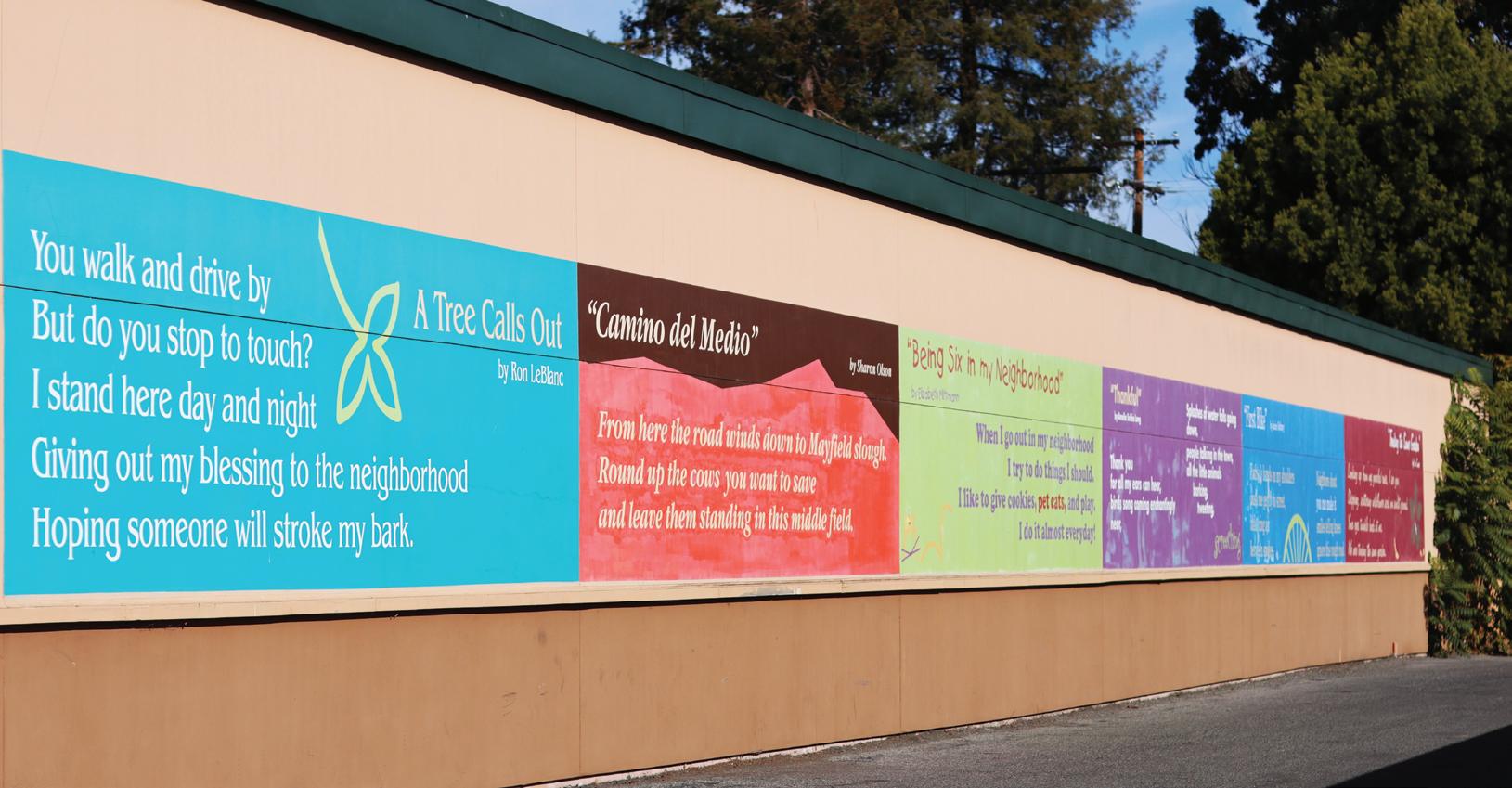
“One lady said that she taught her child how to read from the mural,” Glanckopf said. “Some of the artists, especially the mothers of the little kids that did the work, talked about
how meaningful it was for the kids and how it changed their life and their direction.”
ough Lee said she respects that the poetry wall represents Palo Alto’s history, she would also appreciate a di erent mural that brings people together in a new way.
“(A new mural) could give a fresh, new feeling to the wall and be something that younger generations can resonate with,” Lee said. “It would be a fun opportunity to get new voices on there, and I’m sure kids these days would have a lot of fun with it.”
DeMarzo said the commission hopes to provide this space for younger artists and community members when the temporary restoration of the poetry wall is up.
“I would love to do something new and dynamic there and get the Midtown community involved in working with the artist in the design and even the painting of the new mural (to) attract a renewed energy,” DeMarzo said. “It’s really wonderful that we have this partnership with the property owner and that they allow us to do this. So we want to make sure we maintain that relationship.”
Artist Elena Zolotnitsky stares at the droopy, deep-red roses that are resting in a milk bottle. Weeks pass and the ower’s health declines. e water in the bottle becomes rusty orange, the roses mummi ed into their fragile object.
As much as the roses withered, Zolotnitsky’s inspiration blossomed.
“I basically painted the last minutes of them,” Zolotnitsky said. “I experienced a sensation of euphoria and that just stayed with me –– that’s why artists paint.”
e Bryant Street Gallery on 532 Bryant Street in downtown Palo Alto is home to various works of art on display. e exhibitions include sculptures, paintings and works by a new artist, Zolotnitsky.
Founder Karen Imperial said she opened the gallery because she was at a point in her life where she was ready to be the boss.
“I knew I was good at my profession, and I had a vision that I wanted to put out there in the world,” she said.
Manager Jeanne Vadeboncoeur works with other artists to decide what art to display in the gallery.
“We show original works by established and mid-career artists,” Vadeboncoeur said. “Occasionally, we work with new artists emerging on the scene. We primarily show paintings, drawings and sculptures.”
Many artists like Zolotnitsky display paintings at the gallery to showcase their talent and spread their passion for art.
e gallery opened 20 years ago and o ers in-home art consultations, full-service custom framing and installation, and a gallery of rotating exhibitions.
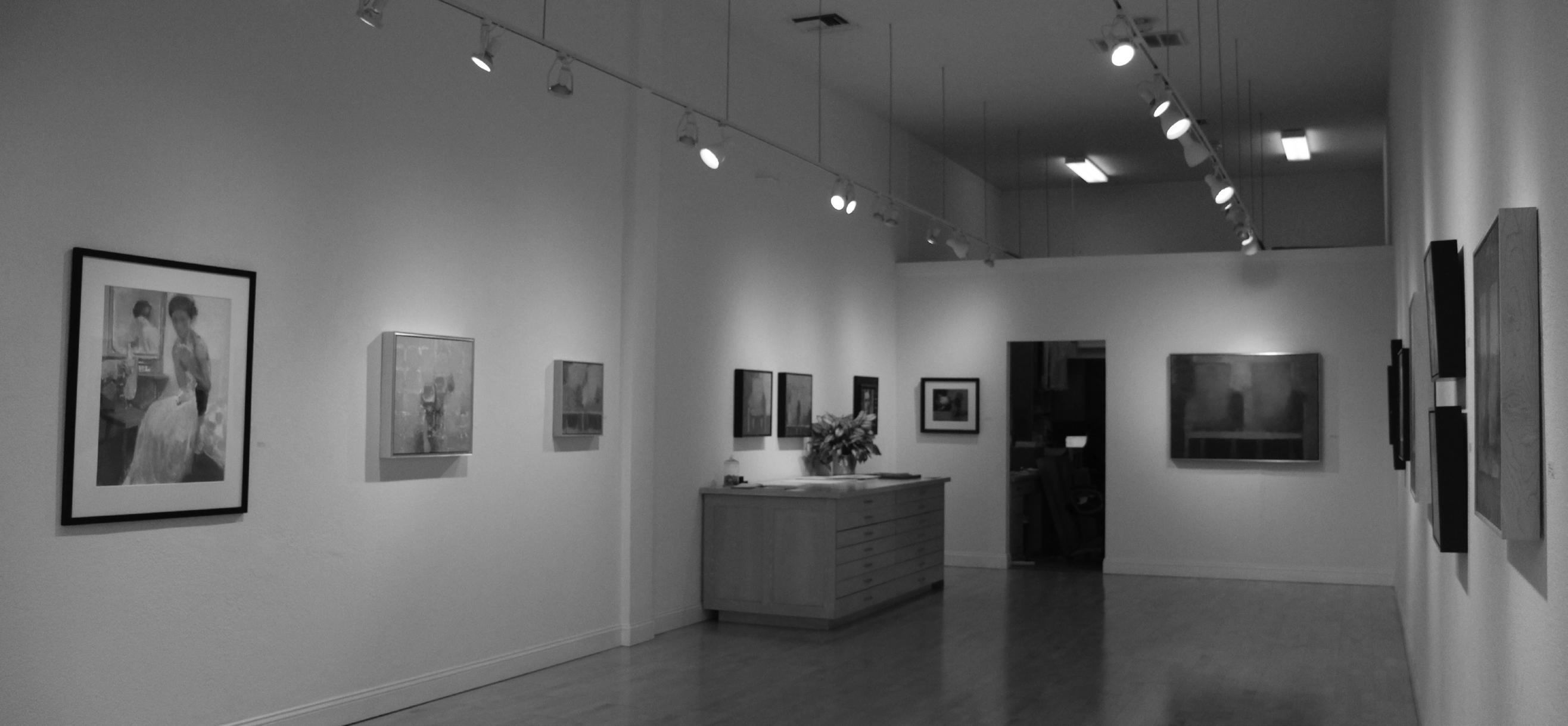
“Including our other locations, we currently have six employees,” Vadeboncoeur said. “Our other locations include our second gallery, K Imperial Fine Art, and our picture frame shop, Bryant Street Picture Framing.”
Lillian Clark Lifestyle, Sci/Tech EditorUnder the red lights on Fulton Street, senior Alden Backstrand walks down the festive, brightly lit “Christmas Tree Lane.” Backstrand, who lives on the street, has fond memories of both decorating her own house and surveying the street with her family to embrace the Christmas spirit.
“My favorite thing to do in Palo Alto during the holiday season is to walk down Christmas Tree Lane with my family,” Backstrand said. “Every year, my entire family walks down the street on Christmas Eve, and it is one of my favorite traditions.”
Having lived on Christmas Tree Lane since 2010, Backstrand and her family have seen the street evolve over the years and always loved helping to decorate it.
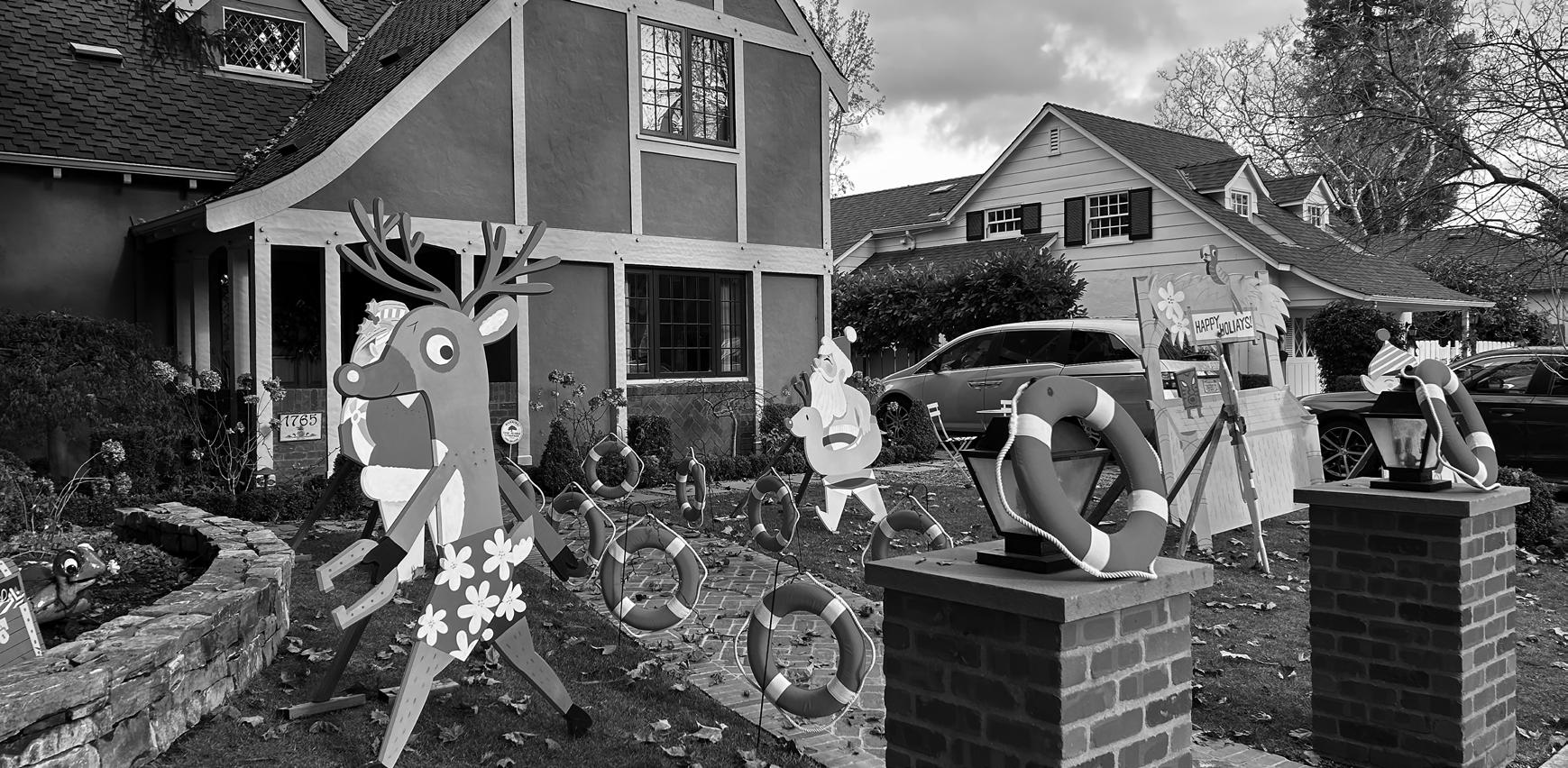
“I have loved growing up on Christmas Tree Lane, and every year, my family sets up the house together,” Backstrand said. “I think that my street really comes together and works hard to spread holiday cheer and makes it a place people want to come to visit year after year.”
As a result of her closeness to the street, she thinks everyone should give it a visit.
“If you want to get into the holiday spirit or have quality family time, it’s a great place to go,” she said.
While senior Ryan Hudacek celebrates both Jewish and Christian holidays throughout the holiday season, she agrees that Christmas Tree Lane is a great holiday activity regardless of religious a liation.
Despite the gallery’s long longevity, it has faced many challenges over the years including keeping up with technology.
“As important as art is for the soul, it’s also one of the areas that many categorize as a splurge and is one of the rst areas we see getting cut back on during lean economic times,” Vadeboncoeur said. “Keeping up with technology and how it has changed the way and the rapidity of how we consume and communicate has also proved a challenge at times. Especially how to intertwine the online with some of the more traditional aspects of the gallery experience.”
Despite the change in technology, the gallery continues to look for consistent and quality works of art.
“We also look for artists that are not too redundant with artists we are already showing,” Vadeboncoeur said. “And we look for work we think will resonate with our collectors.”
e current exhibition includes Zolotnitsky’s work titled “#eatpraylovepaint.”
Zolotnitsky paints portraits of people and objects.
“Elena does traditional work in terms of landscape, still life and portraiture,” Vadeboncoeur said. “Even though it has a very traditional feel, the work is very contemporary. So it’s really interesting because she straddles both worlds as the work works in a modern setting. But her approach, the subject is very traditional.”
Additionally, the gallery is working to incorporate many of Zolotnitsky’s pieces into this exhibition.
“ is show we wanted to do a broader range, and focus on the breadth of her work,” Vadeboncoeur said.
Zolotnitsky’s personal favorites include pieces from her extinct and contemporary collections. “ e most recent ‘Somewhere over the rainbow’ is a oral piece, ‘Love Shimmers,’ and ‘Moonlight,’” Zolotnitsky said. “‘Moon Red’ is being presented in the gallery right now.”
Zolotnitsky also draws inspiration from nature and is proud of her art career.
“When I can pay for my studio rent, I think it’s pretty successful,” Zolotnitsky said. “As soon as you get into that mode nothing really matters. If you are in line with what you do and understand where you go I think that’s successful. When I’m not bored, it’s also successful. Art has always been that major light for me.”
Zolotnitsky said that she often draws inspiration from herself and emphasized the importance of staying true to oneself.
“I sing my song,” Zolotnitsky said. “You have something inside you that you have to nurture and that you have to defend yourself from all these art trends then because then you will become a trend and nd another trend and where are you? You will be lost in all that. You have to be the person that you are.”
Zolotnitsky’s exhibition will be shown until Dec. 23. Admission is free.
Elizabeth Gulman Sta Writer Shamsheer Singh Sta WriterCalifornia voters overwhelmingly voted Yes on Proposition 1, a ballot measure amending the state’s constitution to create an explicit protection for reproductive freedom.
Abortion and reproductive freedom rights have been a controversial subject and a magnet for political discourse, typically along partisan lines, despite this measure’s approval on Nov. 8.
In June 2022, the Supreme Court, in a landmark ruling in Dobbs v. Jackson Women’s Health Organization, overruled Roe v. Wade and shifted the power to legislate abortion to individual states.
Post Dobbs, several states have embarked on legislation focused on either restricting or expanding abortion rights.
Kansas, the rst state to vote on abortion rights since the Dobbs ruling, rejected a ballot measure restricting abortion.
Soon after, the California legislature voted to include Proposition 1 on the ballot for the November 2022 election.
Junior Evelyn Zhang said she is encouraged by the protection of rights that Proposition 1 enshrines in the state constitution and hopes its impact will extend beyond the state of California.
“ is is an important measure for California because it sets an example for other states,” Zhang said. “Ever since the overturning of Roe v. Wade, abortion is now solely determined by states, so state governments wield a lot of power in this scenario.”
Despite the anti-abortion measure being defeated in Kansas, there are only four abortion clinics in the state, leaving the vast majority of the state without easy access to reproductive services.
According to junior Sarabeth Huang, the passing of Proposition 1 could possibly remediate this issue.
“Although we probably expected California to be prochoice, this still has a positive impact as an opportunity for women out of state to travel in and get abortions,” Huang said. “Having access to these resources is very important.”
However, senior Ash Mehta said that for economic reasons, it may still be di cult for people outside California to travel to the state to get an abortion.
“Criminalizing abortion on a state-by-state basis creates socioeconomic disparities; wealthy people will nd a way to travel out-of-state for an abortion, whereas people who cannot travel out-of-state will either resort to dangerous, illegal measures, or be forced to give birth,” Mehta said. “ at is not even discussing the insane cost of pregnancy and giving birth in the US, let alone the cost of raising a child.”
While unsure of any near term impact of Proposition 1 on Californians, Mehta said they are reassured by the constitutional protection it provides.
“I would say that there is no way abortion would ever be made illegal in California, but that is probably what someone would have said about Roe v. Wade thirty years ago,” Mehta said. “I think that this adds more protection to abortion rights in California, because we honestly don’t know what California will look like twenty years from now.”
“If one person were visiting Palo Alto, they should de nitely visit Christmas Tree Lane,” Hudacek said.
As for non-Christmas activities during the holidays, Hudacek said it is important to be involved with people who share similar interests or celebrate the same holidays.
“I think the most important thing when looking for holiday activities is to be involved locally with others,” Hudacek said.
Economics teacher and longtime Palo Alto resident Debbie Whitson also said taking a walk around Palo Alto’s neighborhoods is a great local activity.
“I would say a walk in the evening to see the neighborhood lights with a hot cup of spiced cider or hot chocolate,” Whitson said. “We have friends of various backgrounds and religions who would enjoy this kind of outing.”
Whitson also suggests visiting Stanford Shopping Center for something that doesn’t involve the classic neighborhood Christmas lights stroll.
Whitson said, “I would also suggest visiting the Stanford Shopping Center with all the lights and decorations, and don’t miss peeking into Sigona’s Market with all the special holiday foods on display.”
Los Altos Councilmember Kavita ankha said the Democratic leadership in California was a big reason for why the ballot measure passed.
“I am heartened that California voters voted to enshrine protections for our right to choose in our State’s Constitution,” ankha said. “We must continue to uphold reproductive justice and compassionate care in our laws.”
At the typical snack or dessert or boba shop, customers increasingly place their orders through an iPad or tablet. After paying, the screen displays a set of tip options, which seems to leave many customers puzzled. If a business takes out the human interaction aspect of service, should a customer still leave a tip? And if so, how much?
Tipping options almost everywhere have increased, and even student employees who work in the foodservice industry are frustrated by the increase in product prices along with the increase in expected tips. is is especially the case when the customers are not being served by people.

Senior Maya Quinlan, an employee at Manresa Bread, said tips are reserved for when a worker performs a service for a customer.
“It’s something you should do when you’re getting served at a nice restaurant, or if someone is making you a drink or a food,” Quinlan said. “ ey should be getting tipped because it’s a service.”
Since Quinlan doesn’t work in a sit-down restaurant, she said she doesn’t always expect tips and doesn’t make much money through them.
“When I started working, I would make more e ort to get people to tip me,” Quinlan said. “But I can’t even see if I get tipped. Also, I only make co ee, so it doesn’t really bother me if someone chooses not to tip.”


Quinlan also said more places are asking for tips now, even when she thinks they shouldn’t be.
“I think that in some cases, it’s
Gulman Sta WriterJunior Coral Johnson sits at her desk busily typing an essay, faintly illuminated by the glare from her computer screen.
Her eyes rest for a second, shifting towards the window, where she catches a glimpse of the sky.
To her dismay, the once blue and pinkish sky has transformed
part of tipping is having human interaction since they’re actually servicing you.”
However, Hussein says she has been tipping more at restaurants after starting her job because she empathizes with waiters.
“I have been tipping other workers a bit more, especially (at) sit-down restaurants,” Hussein said. “I’m more aware of all the work that goes into being a waiter.”
Wang also said he has begun tipping more at other places after getting his own job because it helped him understand the workers.
However, Quinlan said she has noticed at her job some people who choose to tip regardless of whether or not there is service.
“A lot of people tip without it re said. “Some people tip all the time, and others choose to not.”
Brianna Zhou Sports Editor
into a vast expanse of jet-black. To her left, the digital clock reads 5 p.m.
Like many students experiencing di culty concentrating and tiredness, Johnson said she struggles to adapt to the annual transition out of daylight saving time.
According to the American Academy of Sleep Medicine, in fact, the transition into and out of daylight saving time can lead to an increase in sleep disruption, mood disorders and suicide.
In 2018, voters approved Proposition 7, allowing the California legislature to end the constant clock changing statewide.
However, the proposition didn’t change daylight saving time; instead, it gave the legislature the ability to change the law if they earned a twothirds vote and the federal government’s approved, which has not happened.
“I’ve noticed that as the days start to darken faster, my concept of time changes,” Johnson said. “I nd it harder to do work when it feels like I should be sleeping.”
Junior Trey Collins said that while the shorter days during winter a ect his mood, he nds that surrounding himself with others can improve the e ects of isolation.
“I think shorter, colder days always will a ect my mood because I am forced to be inside rather than outside and enjoying the day,” Collins said. “Being with other people while being inside to socialize can make it feel less isolating.”
According to AP Psychology teacher Christopher Farina, if individuals nd themselves feeling symptoms as a result of the transition into or out of daylight saving time, they should spend more time outside.
“Make sure that you’re getting some kind of sunlight exposure every single day during the winter so you’re not spending long stretches (of time) inside with arti lighting,” Farina said. “In the spring, make sure to go to bed earlier so you’re not losing an hour of sleep.”
Farina also said if people are being deprived of sleep, they may experience changes in their current state which can lead to additional health conditions.
“While (losing) one hour of sleep may not be the biggest di erence, it can lead to short-term depression and poor cognitive functioning,” Farina said. Despite the various ways to reduce the psychological e ects of daylight savings, Collins said he still thinks the winter blues a ect people on a larger scale.

“ e cold and shorter days are a form of social friction, making it harder to interact with people as freely or spontaneously because we are all inside for a lot of the day,” Collins said. “Overall, it does a community as a whole.”
Hannah Singer News/Opinion Editor
People are always so surprised when they nd out I’m Venezuelan. e conversation goes from “Wait, you speak Spanish?” to “You don’t look Venezuelan.”
Seemingly insigni cant comments like these make me wonder how to escape the categorical box I am continuously placed in. When people invalidate my Venezuelan identity by commenting on my physical appearance, I feel that my legitimate culture is denied in order to protect the indi erence of others.
My grandparents immigrated from Europe to Latin America in the 1940s. My dad was born and raised in Caracas, Venezuela moved to the United States when he was 25 years old. While my dad may not have the ancestral Venezuelan phenotype,
As a result, I don’t have the stereotypical Venezuelan appearance. Yet, like my dad, I still identify as Venezuelan and Latina because I was raised within that culture.
And I’m not the only one. Immigrants in America are constantly told they don’t belong because of their accent, looks and history. eir children, born in America, learn to adopt American customs to veil their familial ethnicity.
Some of us try to hide who we are by changing our appearance, and others of us try to change our appearance to show people that we belong to another culture.
By behaving in this way, we are su ocating our self-expression and our culture, and we are Latinas aren’t just the cookie-cutter version of what Hollywood portrays us to be. Our looks don’t necessarily align with exotic, brown, spicy depictions that are widespread across pop culture. Latina is not a color; it’s a culture.
We live in a modern age, where society is much uidity and sexuality, however we still place humans into categories.
ese labels were created centuries ago from unfounded assumptions and stereotypes to enforce discrimination and marginalize communities.
erence, labels can invalidate our identities and enhance the partition of ethnic communities. It’s time we give up the subtle segregation society coerces us into su ering.
Currently, there are no de nitive labels that can describe anyone because each individual is the physical embodiment of the many people with various ethnicities that make up our genealogical tree.
Even the professionals can’t agree on a single de nition of race and ethnicity, so how can we so easily place others into a category? Do we know, just by looking at others, where their family is from? With what culture they identify with?
However, we as a society need to adjust how we assign them and rede ne the labels by placing an equal emphasis on geography and culture. Growing up with Latin American culture should be equally important as having the Latina phenotype.
I am white and Latina. I have white privilege, which means I have bene ts due to unconscious bias, like being able to display my culture of being Venezuelan without any consequences.
However, because I am white, people would never know or even assume that I am Latina.
Like you, I am more complex than a checkbox could ever be, so don’t try to make me choose between Caucasian and Latina. Don’t tell me I don’t look Latina, even if I am white.
Isn’t it time we start choosing our identities instead of having them chosen for us?
Why can’t we just be who we are, without having to validate our identities with random labels that don’t apply to us?
In a nation that claims to be the land of the free, how liberated are we if we are obligated to chain ourselves and others down to inaccurate identities?
What if I told you that I was Jewish as well? Can I be both Jewish and Latina, because neither of them are mutually exclusive?
Or will you just place me into another category based on designated characteristics, and box my
Junior Samantha Mann was elated when
she received the presale code for Taylor Swift’s Eras Tour concert tickets through her email. She geared up for fateful Tuesday morning in the middle of November only to nd that there was a delay from the website crash.

When the afternoon nally rolled around, Mann logged onto Ticketmaster, holding her breath as she clicked the button to get in the queue.
Seconds passed, then minutes, until she eventually realized she had been sitting there for three hours, painstakingly waiting for her place in line to move up by a couple thousand people.
“Once I nally got into the ticket purchasing page, everytime I tried to click on a ticket, it noti ed me that someone else had already bought it,” Mann said. “Finding out that there were no more tickets left was the most frustrating and disappointing part after the wait.”
Swift returned to the center stage with a bang as she released her new album “Midnights” in late October and subsequently announced her in nearly ve years. Her last world tour had been the Reputation Tour in 2018.
Starting in March, the U.S. leg of the Eras Tour will span 20 cities, with international dates to be announced shortly.
In November, several presale opportunities opened across di platforms, such as SeatGeek and Capital One, allowing fans to enter a lottery-style drawing system to purchase tickets early.
Mann said she was excited for Swift to go on tour because of her love for the artist’s music and the anticipation that has built up over the past years, with re-releases and new tracks.
“Hopefully, we can still nd decent resale prices,” Mann said. “I understand that it has always been a struggle with

a platform like Ticketmaster but I’m not giving up yet.”

According to Ticketmaster, the ticketselling site serving as the o cial selling partner for the Tour and the platform
presale event in history, there was an overwhelming demand for tickets. Biology and chemistry teacher Mary Haddad participated in the Capital One presale, where any cardholder can queue for
are well written –– if you’re listening to the words, you can kind of understand what it is that she must have felt throughout her (experiences),” Haddad said. “I was planning on visiting my best friend, who I never (get to) see since she lives in Seattle, to watch the show together in the summer.”
culties with their online systems, Ticketmaster said the website crashed a couple minutes after the original presale time as 14 million people simultaneously rushed to secure their tickets.
As a result, Ticketmaster had to delay ed Fan Presale Event by ve hours and cancel the general ticket sale which was originally scheduled for Nov. 18.

However, Haddad said purchasing tickets was not a fair process for fans.
“All fans should be able to go to the stadium that’s closest to them if they can ord the tickets, and they should not have to buy a resale ticket,” Haddad said.
A long-time supporter of Swift, sophomore Aria Shah said she has been waiting for the singer to go on tour for the past couple of years.
Shah purchased the tickets for the tour using her presale code, and although the seats were not her rst choice, she is still excited about the opportunity to attend
“Honestly, I’m just glad I was able to get tickets when some people could not even get out of line, and I can’t wait to see her incredible stage presence paired with her choreography,” Shah said. “I also think the whole concept of an Eras Tour is so cool because I’ve grown up with her music, so it’ll be like my whole childhood is coming back in one night.”
Football won the CCS Division V title in a 27-24 victory over Monterey High School on Nov. 25. With the championship win, the team secured its rst CCS title since 2010 and advanced to the state tournament.
e CCS victory capped o a six-game win streak, which ended on Dec. 2 in a 30-20 loss to Santa Teresa in the state tournament.
Senior and running back Jack Newman, who scored two touchdowns in the CCS championship game, said winning the CCS title was meaningful because of the team’s resilience.

“It means everything,” Newman said. “After such a bad start to the season, being able to rally as a team and win CCS, it’s freaking incredible.”
But head coach David DeGeronimo said the loss to Santa Teresa in the CIF Division 6-AA NorCal Regional Championship game was partly due to poor play in the second half.
“I thought we had control of the game until mid-third quarter, and then things kind of unraveled on us,” DeGeronimo said.
Senior and linebacker Lincoln Tutor said Santa Teresa’s special teams played a role in the defeat as well.
“On special teams, every time they punted, it always went to the two-yard line,” Tutor said.
“On kicko returns, (we) always started at the two- or three-yard line. We had really bad eld position the whole game, and that’s probably a big reason why we lost.”
Tutor also said the fact that the team came so far after a 1-6 start shows how they learned to persevere through tough losses.
“When we lost to Leland, when we lost to Homestead, we knew we could’ve beaten those teams,” Tutor said. “We believed in ourselves. We knew that we could do a lot. We can go far. (We) never gave up hope.”
Assistant principal LaDonna Butler, who oversees the school’s athletic program, said she was impressed with the team’s ability to revive its season and make it so far into the playo s.
“I am extremely proud of our team,” she said. “ ey had a very slow start, a new coach who’s changing the culture of the team, and they fought hard tonight,” Butler said. “I’m just excited for how successful they have been this year.”
Butler also said she was proud of the student section for its sportsmanship during the game.
She said student fans have made a signi cant improvement in having sportsmanship since the Sept. 9 incident where Paly students rushed Gunn’s bleachers during the crosstown rivalry game.
e students were doing the things we’ve asked them to do,” Butler said. “Sometimes, challenging circumstances happen. We might make a poor choice, but then we talk about it, gure out what the norms are going to be, and then we get to experience opportunities like tonight.”
Despite the loss, DeGeronimo said the season was successful and his players formed a strong connection with each other.
“ ey love each other like brothers, and they play hard for each other,” DeGeronimo said. “We started out 1-6, and we nished 7-7 and were CCS champs. ese guys just needed to develop, and they developed quickly and started to understand the system.”
Shetty Sta WriterSenior Delaney Ball looks out at the gray rippling currents below Staten Island’s Verrazzano-Narrows Bridge and takes a deep breath. e chilly morning air buzzes with anticipation: surrounding her are 44,000 people, all of whom are about to embark on a 26.2-mile run through the ve boroughs of New York City.
On Nov. 6, Ball completed the largest marathon in the world — the New York City Marathon — and raised $3,500 for Partnership to End Addiction, a nonpro t organization that organizes campaigns to stop teenage drug and alcohol abuse in the United States.
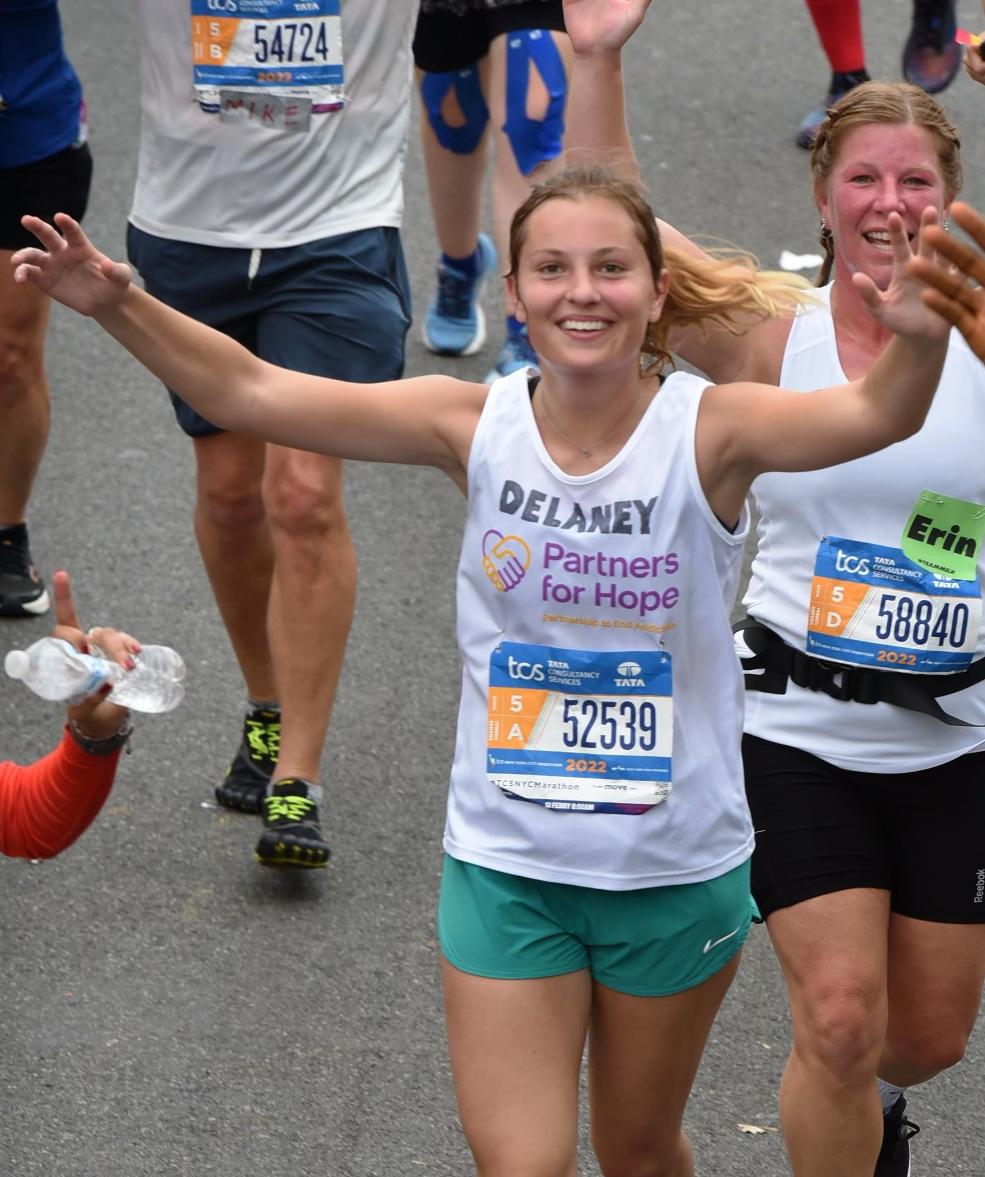
Ball said she began seriously thinking about running a marathon this year after spending her childhood watching her mom run in them.
“Just seeing my mom run marathons inspired me,” Ball said. “Knowing that she put in all this work, and seeing her out on courses trying her hardest really hit me.”
Ball said she chose the New York City Marathon as her rst marathon because of the large running community that thrives there.
“I wanted to choose a race for my rst race that was going to have a ton of crowd support,” Ball said. “I knew it was going to be an incredible rst marathon to run and something I’ll never forget.”
Ball said she and her mom also decided to run in support of Partnership to End Addiction because they wanted to raise awareness for drug addiction and give themselves a purpose to run.
“Substance use and addiction a ects more than 20 million Americans,” Ball said. “ e road to recovery can be long and hard, which is what my mom and I will keep in mind (for) each of the 26 miles we run, especially in those hard miles at the end.”
To prepare for the marathon, Ball said she followed a rigorous six-month training schedule with her mom that consisted of one long run each weekend.
“I started out with one mile, and then I went to four, and then eight, and then 12,” Ball said.
Ball said she would often wake up before the sun rose to train at far-away locations like the Golden Gate Bridge.
“I like to sleep in,” Ball said. “But (my mom) would get me up at 5:30 or 6:00 in the morning sometimes because we would do destination runs.”
Ball said her mom was her biggest motivator to continue with the rigorous training.
“If I didn’t have my mom to train with me, I don’t even think I would have been able to motivate myself to get up and run each weekend,” Ball said. “My mom was really my biggest supporter in the training process.
But two days before the race, her mom unexpectedly fell sick.
However, Ball didn’t back out.
“At rst, I was a little disappointed because I wanted to do it with her,” Ball said. “But then once I got into (the race), I was like, ‘ is is just like the training runs.’”
On top of not running with her mom, Ball said the weather was more intense than she expected during the marathon.
“It was the hottest day on record for the New York City Marathon,” Ball said. “It was 73 and sunny, which is not ideal running weather.”
Ball said the biggest challenge she had to overcome took place during mile 20 of the marathon because she had never run beyond that distance during her training.
“When I got to mile 20, I literally broke down,” Ball said. “It was one of the hardest things I’ve ever done. I had no fuel.”
Even though Ball wanted to give up, she said the support from the crowd and her family kept her going.
“It was like the biggest party in New York,” Ball said. “ ere were people (cheering) from mile one all the way to the nish line.”
Ball said her mom’s encouragement from the sidelines gave her the nal push to keep going.
“I really had to be strong in the moment,” Ball said. “I remember calling my mom and crying on the phone to her to tell her, ‘I don’t think I can do this.’ And she just reassured me that (I’d) be OK.”
When Ball reached the nish line, she said she felt overwhelmed that she had accomplished her goal.
WriterAfter placing fourth at states, members of the cross country team said they feel better prepared for the future and have set goals for themselves to improve moving forward.
Junior Grant Morgenfeld, the only representative of the boys cross country team at states, said he gained valuable experiences from competing there.
“I didn’t meet the goals I had set, but being able to witness some great competition around me was hugely bene cial,” Morgenfeld said. “I’ve come to learn that cross country is going to have ups and downs, and it is more about how you respond to your o days.”
Morgenfeld said he plans to use the lessons he learned at states to improve his performance.
“I feel stronger after the state meet,” Morgen eld said. “Every setback is an opportunity for improvement, and I believe I am better prepared to take on tougher challenges in the future. I hope Paly as a team can take this energy, on the girls and boys side, and continue it into our upcoming track season.”
Senior and girls co-captain Hillary Studdert said even though her team wanted more from the state meet, she is still proud of her individual performance.
“We came in ranked fourth and got fourth, so we came away satis ed but wanting more from the team race, especially because we placed three in the top seven,” Studdert said. “I surprised myself a lot at state and am proud of how I put it all on the line for my nal high school cross country race. I was excited to cross the line with my two teammates right there.”
Studdert also said she hopes to carry her performance over to track and eld in the spring.
“I am really excited for my senior track season, and I have set big goals for myself coming into the season,” Studdert said.
Senior Finley Craig, Studdert’s cocaptain, said she agreed with Studdert on both topics.
“I believe we did exactly what we wanted to,” Craig said. “We all just tried to do our best with the conditions we were given, and that went very well. I am feeling very excited for track. We all just got o our week-long break, and we’re getting ready for some really fun post and preseason training.”
“It was honestly one of the hardest physical challenges I’ve gone through in my entire life,” Ball said. “I cried because I was so happy to nish. at was my one goal. I didn’t care about my time.”
Ball said she plans to continue training to run in even more marathons in the future.
“My ultimate goal is to qualify for the Boston Marathon,” Ball said. “I think that’s something I would do later in life, when I’m in my twenties. I don’t think it’s achievable at this moment because I’m just so busy.”
Ball also said the Marine Corps Marathon and the Chicago Marathon are on her bucket list of marathons as well.
Ball said, “( is marathon) taught me that if you want to do something and you work hard for it, it can happen.”
Although the varsity boys basketball team defeated Overfelt High School 50-41 in its home opener, head coach Je LaMere said the team still has room to improve.
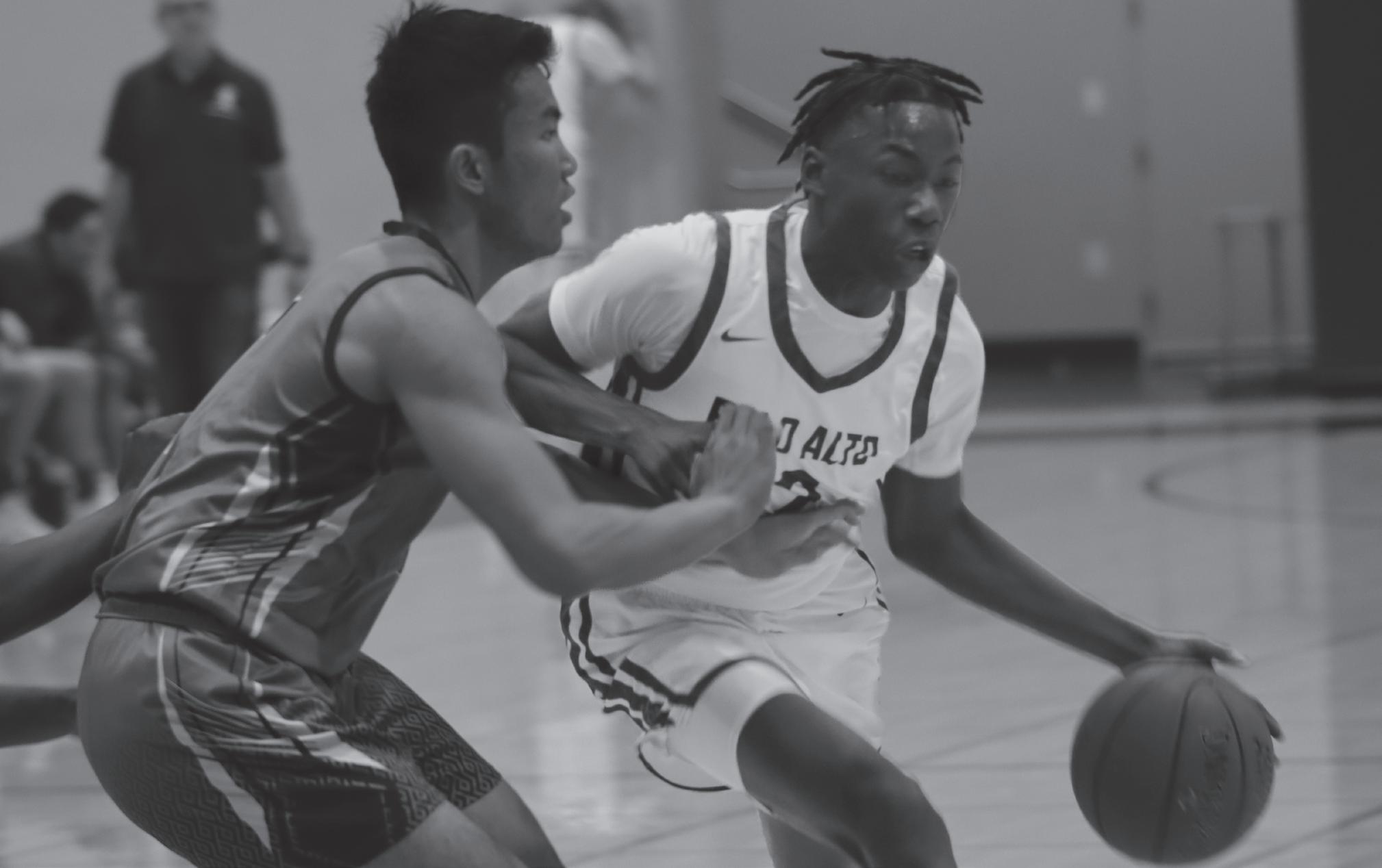
“At the end of the third quarter, we got very sloppy, and I think that gave them a little bit of life,” LaMere said. “But it’s good to be in a game like this early in the season, where you get a little bit tight, and you have to gure out how to win.”
While Overfelt started to gain points in the fourth quarter, LaMere said these types of games challenge the team to be its best.
“ ese game situations are what make you better throughout the season,” LaMere said.
As a result of his newly-formed team, LaMere said he hopes the players face a variety of playing styles throughout the season.
“We’re a very young team, and a very inexperienced team, so all these opportunities we have will help us get better,” LaMere said. “We want to play teams that push us and teams that give us di erent schemes.”
Senior and team captain Jackson Martin said the team plans to grow stronger by improving o ense and communication.
“Our rst step is working on zone o ense, and then another main goal that we strive for this season is improving communication through the whole game,” Martin said.
While he acknowledged opportunities for improvement, Martin said the team ultimately achieved its goal in the rst home game of the season.
“A win is a win, and that’s our goal at the end of every game,” Martin said.
Martin also said playing with passion will help the team remain successful.
“Our goal is to just play the way we love to. We all know the game and are doing our best to put it all together,” Martin said. “If we can play the way we are supposed to, we can be a very hard team to beat.”
Vostrejs Guest WriterFollowing a successful season where multiple wrestlers placed at CCS, coach Jonathan Kessler said his large team has high expectations for this season.
“Right now, we have 30 boys and 10 girls, which is the most we’ve had in a while,” Kessler said.
Kessler said that while the team hopes to perform well, he recognizes most wrestlers are motivated by personal goals.
Senior and co-captain Joshua Wilde said he has his sights on states.
“Personally, I want to get to states, and I want to do good in states,” Wilde said. “ at’s been my goal for the last four years.”
Senior and co-captain Hailey Oshita said she has similar aspirations.
“(My goal is) CCS and then to go to States and hopefully do well,” Oshita said.
For seniors like Wilde, wrestling has affected him in ways beyond the competition. Wilde said that for him, wrestling has ignited his personal growth.
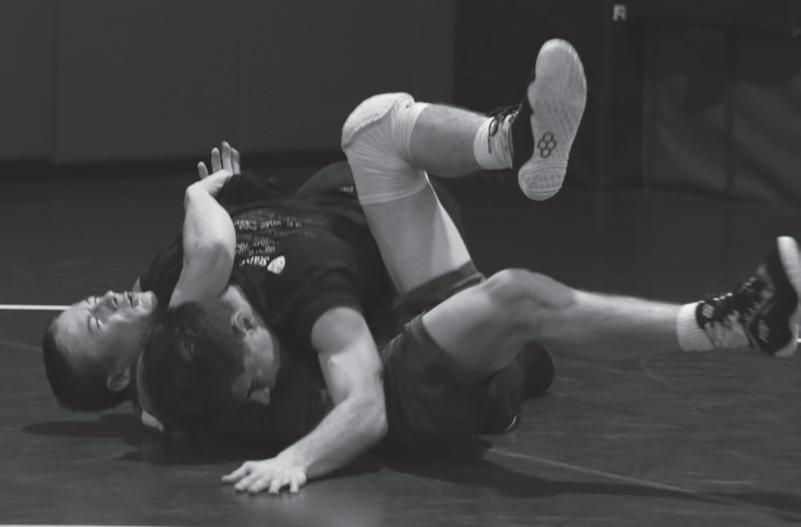
“I think because of wrestling and because of how di cult it was, I’ve changed a lot more than I would have than with any other sport at Paly,” Wilde said. Oshita also said wrestling has taught her many valuable life lessons and skills.
“It teaches you a lot about working hard and making a goal and working to achieve your goal,” Oshita said.
Kessler agreed and said he also thinks wrestling helps prepare athletes for success beyond the sport.
He said, “ e best part is that you learn so much through the sport, and it’s not just how to get your hand raises. It’s how to go through life.”
Lin Guest WriterSophomore
e ball travels up the onds, goes rejoice in celebration.
In 2010, the International Federation of Association Football selected Qatar to host the 2022 Men’s World Cup. At the time, Qatar did not have the stadi ums, hotels, and high ways needed to hold the competition.
However, many migrant workers were already living in the country on employment visas, which is common in the Middle East, and many more traveled to the Arabian Peninsula from Asia.
ese migrant workers built eight stadiums for the World Cup in 10 years.
Since 2010, more than 6,500 migrant workers from Asian countries have died because of dangerous working and living conditions.
According to an analysis by e Guardian, the leading causes of death include heat, workplace accidents, car crashes and suicide.
Despite Shah’s passion for watching the World Cup, she said she believes more measures should have been taken
“I think it’s sad that they didn’t have regulations to make sure it was safe,” Shah said. “(FIFA) should have done better.”
History teacher Kenneth Tinsley said these casualties are not surprising given FIFA’s long history of corrup-
“It’s problematic that this international event that’s supposed to promote unity has been known to be mired in corruption,” Tinsley e high amount of deaths is not acceptable for an event that’s supposed to promote unity.”
Tinsley said he especially wants people to recognize FIFA’s faults. “Any person who sees it still should be concerned that (this is) just one of many things that are going on that’s wrong with that event,” Tinsley said.

As they approach the rst game of the season, the girls varsity basketball team is committed to improving communication and emotion, according to head coach Scott Peters.
Peters said implementing daily short meetings before practices has helped the team regroup and focus.
“One of the things that we’re trying to do this year that’s a little di erent than last year is we’re trying to have a talk before every practice, even if it’s just two or three minutes, to focus them on the goal for the day and what we’re looking to do,” Peters said.
However, senior girls varsity basketball player Itzel Torres says that adjusting to working and communicating with a team has been a tough obstacle.
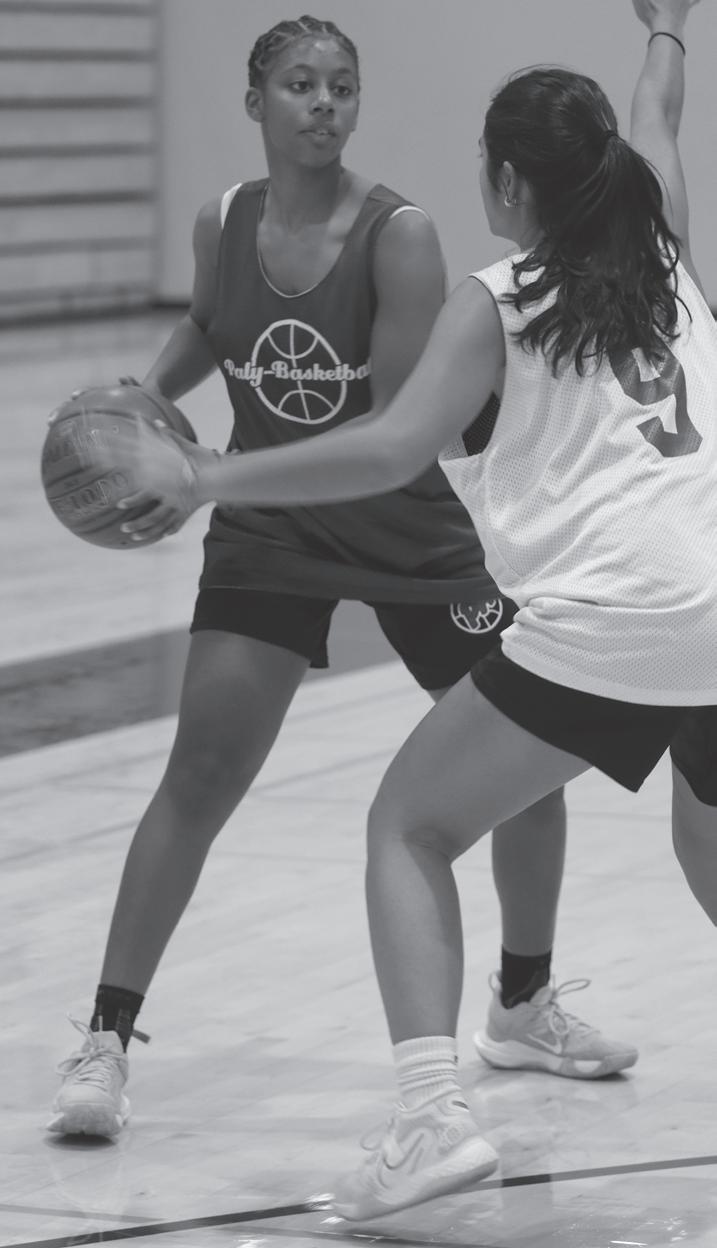
“I feel like practices over the summer (were) a lot more intense because I (had) to train to make sure I’m prepared for the season.” Torres said. “But now being with the team, we have to care more about being a part of the team rather than being by ourselves, so it’s kind of harder.”
Despite these necessary adjustments, Peters said he is con dent in the team’s performance and acknowledges the team’s dedication.
“ ere’s been a lot of e ort there and a lot of time the girls have sacri ced in order to do this,” Peters said. “We hope that pays o .”
Along with the rest of the team, Peters also said he has high expectations for future games this season.
“We’ve got to share the ball, support each other’s successes and work together to help,” Peters said. “I think we were a very good team last year, and I think if we continue to work hard, we’ll be a very good team this year.”
Sophomore Zachary Crystal who plays on the JV boys soccer team said he discovered the news online and was shocked to nd out that many migrant workers had died from the inhumane conditions they had been working in to prepare for the World Cup.
“ is made it con icting for me to watch the World Cup because it’s something I love to do, but it feels wrong sometimes,” Crystal said.
However, Crystal said there are other controversies surrounding the tournament.
“First of all, it’s in the winter instead of the summer, which intersects with the players’ club seasons,” Crystal said. “ is has caused many players, especially in France, to su er injuries that take them out of the running. Stars like Benzema and Sadio Mane won’t participate because of this.”
Additionally, homosexuality is illegal in Qatar, so players are not allowed to wear the OneLove armbands, which are a symbol of LGBTQ+ rights.
As a result of the mundane location, inhumane conditions and other controversies, Crystal said he has had a negative experience.
“All this controversy has made the (World Cup) a bit less enjoyable and makes FIFA, who is notorious for corruption and their decision to let Qatar host the World Cup, very questionable,” Crystal said. “Despite all this, I’m still going to watch and enjoy the World Cup and keep rooting for my teams: (the) USA and France.”
Elizabeth Gulman Sta WriterF
Like many sports teams, the eld hockey team organizes bonding activities so players can grow closer.
Senior Jess Watanabe, who is the captain of the girls varsity volleyball team, said the team always takes a trip to Half Moon Bay at the start of each season to bond with each other.
“ is is usually towards the beginning of the season so that we kind of establish good chemistry early on,” Watanabe said. “Other than that, we usually go to Town and Country on Fridays, and we just hang out as a team for an hour or two.”
Watanabe said getting to know her teammates o the court is crucial because volleyball requires a strong team chemistry to be successful.
“When you’re playing with them, you have to have good communication,” Watanabe said. “You have to establish good trust, so I feel like it’s super important for all of us to get to know each other on the court and o the court so that we understand what kind of person they are.”
“I think it’s better to connect with your teammates. It just makes you feel more comfortable around them during matches,” Horn said. “For tennis, occasionally you play doubles, so you’re with another person on the team. If you feel more comfortable with them, you usually end up having a higher chance of winning.”
Freshman Liam Li said the junior varsity football team’s bonding events allow the team to get to know each other’s strengths and weaknesses and rely on each other.
“Football is a team sport, and no matter how many good players you have, if you have a toxic relationship with each other, you can’t make the plays,” Li said. “But as a team, someone’s strong part might be your weak part, and if they can compensate for that, it’ll make the team stronger.”
Junior and water polo player Grace Gormley said activities outside of practices and games have allowed her team to go from a group of athletes to a close-knit group of friends.
“ ese people are my teammates, but they’re also my friends,” Gormley said. “It’s really great to get to spend time with them
in a setting that’s not just a training environment. (Team bonding) is kind of a nice way to both build up our trust with each other as teammates and then also to just get to know each other in a place that isn’t in the pool.”
From a coach’s perspective, Crane said bonding activities can also help teams recuperate after tough losses or hardships during the season.
“In the face of adversity for (the eld hockey) team, they were able to continue to keep morale up and stay positive because they genuinely like each other and get along,” Crane said. “And if that wasn’t the case, I don’t think that our team’s morale could have been as positive as it was during the really tough season like this last season.”
Crane said she allows time before and after practice for the players to have fun making things like TikTok videos or pregame hype videos.
“As a former student-athlete, I know how important it is for players to bond with each other o of the eld in order to cohesively come together on the eld,” Crane said. “To care about and to value and respect your teammates as humans translates to a better connection and team dynamics on the eld.”
Chu Sta Writer Shamsheer Singh Sta WriterHoping to build on last year’s CCS quarter nals nish, the girls soccer team plans to focus on improving team chemistry and assimilating new players for the upcoming season.
Senior and co-captain Adelaide McCarter said last season’s team was comprised mostly of seniors, so she is excited to bond with the new underclassmen.
“ ere are lots of new faces on varsity this year which is so exciting,” McCarter said. “I hope to help create a positive team environment where my teammates can have fun, try new things, and make friends.”
While a matter of inconvenience to some players, McCarter said early morning practices have helped bring the team together.
As e Campanile was going to print, information came out that eight girls varsity and one junior varsity soccer player are currently ineligible to play for participating in a club soccer showcase in Mesa, Ariz. from Dec. 3-4, a violation of Santa Clara Valley Athletic League regulations.
According to the 2022-23 SCVAL Soccer bylaws, “(All) winter athletes must have stopped participation in contests for a team outside of the school, in the same sport, by the Monday following anksgiving, if the player is to participate on the high school team.”
A sophomore who also only agreed to be interviewed anonymously said many players hope SCVAL will reconsider its decision after communicating with the club and school teams.
“I just hope nothing is set in stone and we can
“We practice bright and early which can be difcult to be motivated for, but we have so much fun,” McCarter said. “I really value the friendships I have made from soccer over the years and this is a space where others can do the same.”
Senior and co-captain Payton Anderson said she wants to focus on fostering a healthy team environment that will create a more cohesive unit and better team chemistry.
“Last season went well, and we made it to CCS,” Anderson said. “Our team had a strong bond that helped carry us throughout our season. I hope we are able to nd that rhythm.”
Junior Alessandra Chandler, who moved up to varsity this year, said this season de nitely has potential.
“Practices have been going really well and everyone works hard,” Chandler said. “I think our team chemistry is amazing, and I am excited for us to play.”
appeal the decision,” the sophomore said.
Athletic Director Jennifer Crane said the school acknowledges SCVAL’s decision and will try to let the suspended players participate in other capacities that do not go against SCVAL bylaws.

“What Paly can do to (show) support is to allow those a ected by this rule to continue to be a part of the Paly girls soccer program with the exception of being able to play in any contests as identi ed by the SCVAL constitution,” Crane said.
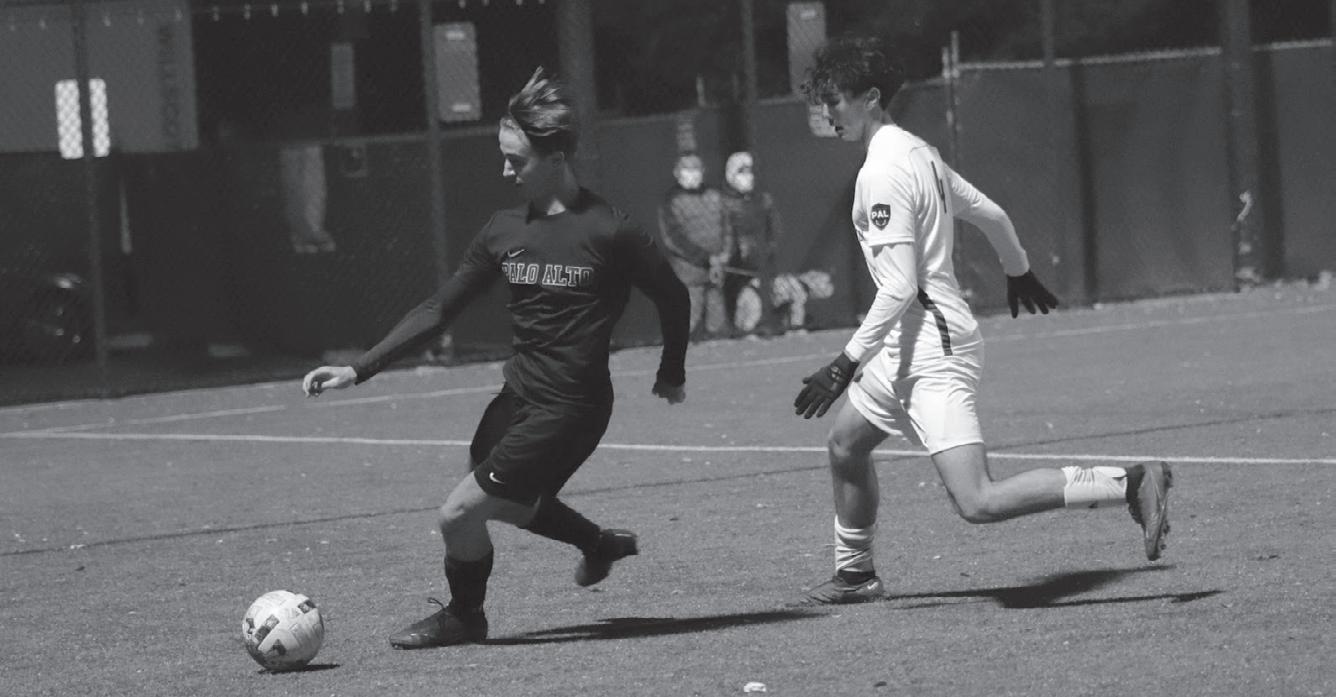
Editor’s note: All players were told to remain anonymous by their coach after interviewing. e team is currently under investigation. An update will be posted on thecampanile.org as more information is available.
Additional reporting by Rachel Feinstein, Gabriella Gulman and Ti any He.
 Sta Writer
Sta Writer
Every four years, millions of soccer (or fútball) fans crowd around their TV to watch the FIFA World Cup, one of the most prestigious and awaited sporting events in the world.
e most consistently strong teams, Brazil and Argentina, often hold the best odds, but in recent years, less prominent teams took the Cup. In 2018, against all odds, the Croatian and French teams went to the nals and France won the event. is year tells another story.
ough Argentina had a heart wrenching loss against Saudi Arabia, the team, starring superstar Lionel Messi, still looks in good shape to go all the way. Messi, regarded as one of the best soccer players ever, has yet to win a World Cup and this year’s is his last chance to do so.
As for Brazil, their star player Neymar Jr. su ered an injury and is reported to be out until at least the end of the group stage. at said, the team is still through to the elimination rounds and looks dangerous on the o ensive.
Brazil and Argentina are the clear frontrunners this year: the juggernaut team from Brazil or the ‘last dance’ of Lionel Messi. After the tragic injury of Neymar, my prediction for the winner this year is Argentina. Messi is going to end his World Cup career on a good note, and this is the ending that he and his teammates are ghting for. According to Fivethirtyeight. com, Argentina is statistically disadvantaged when accounting for roster strength, club wins and quali cation performance. e Statistical Point Index that Fivethirtyeight uses ranks Argentina as the fth most mathematically probable team to win. ough Brazil looks strong on paper, Argentina is going to play the rest of this tournament with strength and will that the World Cup has never seen.
Electronic Arts, a gaming company that makes hyper-realistic sports games, predicts Argentina to be victorious. eir World Cup predictions came true in 2014 and 2021, making the system undeniably authentic. ough a video game, players play in the same manner as they would in real life.
In the future, other teams will compete at the same level as the currently dominant teams and maybe, Argentina will fall. e dynastic rule of the top few teams will hopefully be a theme of today’s FIFA and not tomorrow’s.
e boys varsity soccer team won its opening game in a 2-1 win over Menlo Atherton on Nov. 30.
Senior, defender and co-captain Jonas Pao said the game went well considering it was the team’s rst time playing with each other.
“I thought it was a great performance,” Pao said. “ e boys really came out. We haven’t really played together in a game yet, obviously, so it was great to set a precedent like that.”
Senior and co-captain Zach Cooper said the team was brought together by a former player who could not play this year due to leukemia.
“We have a player who should have been on the team but couldn’t play this year due to leukemia,” Cooper said. “We wore orange face paint in solitude with him and his battle, and it really brought the team together.”
Even with the win, coach Rusty Millard said the team needs to work
on controlling and holding onto the ball for longer.
“I thought tonight there (were) times where we were defending, we got it, maybe gave it away too soon,” Millard said. “So in those moments, we want to be a little better and keep the ball (for) longer periods.”
Pao said the team can also improve by working on its eld organization.
“I was trying to organize the back, and everybody’s really doing a great job to try to mesh together, but de nitely organizing (can be improved),” Pao said.
Cooper said that the team’s potential makes him excited about what the team can achieve this season.
“I want to win everything this year,” Cooper said. “We have such a talented team, and we can’t waste it.”
ield hockey coach Jenny Crane sits in the stands overlooking the StanfordCal eld hockey game, watching her team laughing and talking with each other as they watch the game. Before this event, the team had eaten dinner together at Town and Country before walking over to Stanford. Sophomore and tennis player Audrey Horn said her team bonds by having dinners and boba together, which helps her and her teammates feel more comfortable with each other, which translates to teamwork in-game.The Earth’s population has reached 8 billion, and as a result, advanced countries face a problem: the growing number of the elderly.
According to Pew Research, despite the fact that nearly 20% of Americans live in multigenerational living situations, intergenerational relationships are still rare. When retirement homes are overly expensive and there is no time to care for the retired personally, people face the question: how will we take care of the elderly moving forward?
AP Environmental Science teacher Nicole Loomis said that other countries that have had a disproportionate number of senior citizens for a longer time than the U.S. provide insight into what the future could hold.
“In Japan, for example, one-third of their population is beyond retirement age,” Loomis said. “It means that there are fewer people to do the jobs and the economy starts to shrink.”
However, the shrinking economy is less of a pressing issue due to the large volume of immigrants who support the economy in America. Although future politi cians may push for fewer immigrants, Loomis said that the economy is not the problem at hand, but helping the retired is.
Economics teacher Debbie Whitson said the U.S. established Social Security as the main incentive to help the retired, but it has become outdated due to the rising life expectancy.
“In the U.S., with modern health care and medicines, people live longer than when Social Security was established,” Whitson said. “Social Security was never intended to provide income to retirees for so many years as lifespans have increased.”
And Loomis said as people live longer, the money from Social Security taxes will become scarce.
“People pay Social Security, but as people live longer, that money is running out,” Loo mis said. “So that’s the main issue that we face in a country that is aging.”
According to the Social Security Ad ministration, 6.20% of income tax (up to $147,000) goes towards Social Security programs. However, this money is not enough to support the elderly population as people live longer.
Furthermore, the new life span of America is 77.3 years, which means eligibil ity for Social Security should be shifted to late 60s or early 70s since retirement was assumed to span approximately 5 years when Social Se
curity was established. However, Whitson said that this is a tough social shift that Americans will have a hard time facing.
“It has been a challenge to adjust the mindset of 65 being the age to retire,” Whitson said.
“However, incentives have been made to increase the age of retirement and obtain Social Security bene ts.”
Despite this setback, Whitson said o cials are working to combat the scarcity of money
gradually, and incentives are in place to have workers work longer.”
Additionally, Whitson said that there are incentives in place that will help ease the pushback from seniors who have to work longer in life.
“ ere are ways to provide incentives for them to work,” Whitson said. “Social Security taxes paid by a business for older workers can be reduced, making older workers cheaper to hire, and older workers can continue to earn a salary while also earning their social security check.”
Loomis also said the United States has established a number of assistance programs for the elderly to help them after retirement.
“We have a lot of nursing homes and assisted living facilities,” Loomis said. “But they’re expensive, so the question is how much of the cost is going to be covered by people’s insurance, Medicare or Medicaid.”
Although an option is for the elderly to stay with their families, Loomis said that most adults in the US are already working and are rarely at home to take care of their families.
“Right now, although there is a higher need for assisted living and care, we’re not seeing people step into the jobs,” Loomis said.
However, Loomis said that with further changes in the Social Security system, America could continue to support the elderly for some years.
ey’re increasing the age at which you can collect Social Security so they are trying to deal with the problem,” Loomis said. “So people will be working longer.”
Shiki Toyama Business Manager
An alarm clock chimes, and Senior Divya Mathur rolls over sleepily in her bed. rough bleary eyes, she reads the time: 8:00 a.m. With a groan, she pushes herself up. It feels like she had only fallen asleep minutes ago.
As the COVID-19 pandemic nears its third year, its longterm health e ects have continued to negatively impact people’s daily lives. For some, like Mathur, chronic fatigue is one of them.
According to the CDC, long COVID, or post-COVID condi tions, are ongoing health symptoms that people experi ence after recover ing from COVID-19. e agency’s analysis estimates that up to 20% of Ameri cans experience at least one post-infection symptom that seriously impacts their daily life.

Jing Chiang, a physician at Santa Clara Valley Medical Center, said long COVID symptoms fall under an um brella of many common health disorders, making it di to attribute certain symptoms to long COVID.
“A lot of people have chronic fatigue, which is not speci (to long COVID), and you can get that from many diseases,” Chiang said.
Chiang also said long COVID symptoms can a di erent organs in the body.
“Some people can have long-term shortness of breath and in ammation all over the body, so (symptoms) can be within the lungs, or it could be the cardiovascular system,” Chiang said.
Some students have been experiencing long COVID symptoms long after recovering from COVID-19.
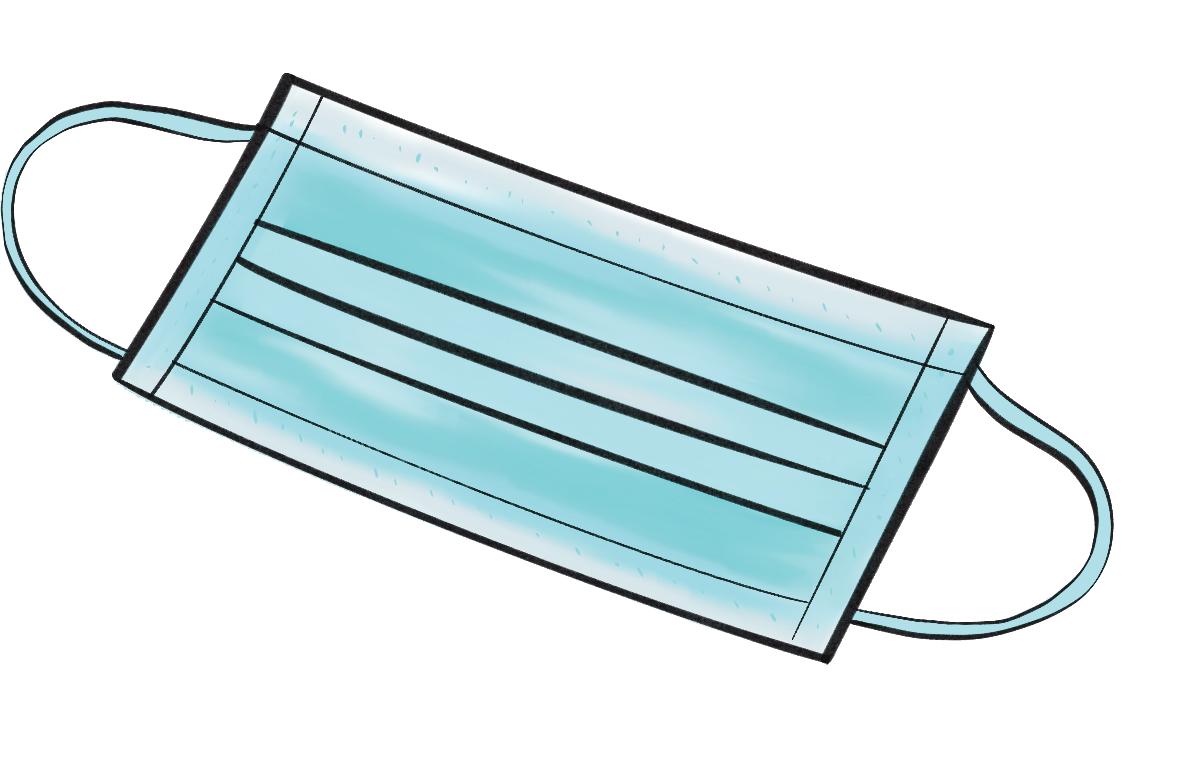
Mathur said she has long-term symptoms that seem to be persisting even months after she contracted COVID-19.
“I had COVID-19 over the summer, and when I had it, I didn’t have any serious symptoms,” Mathur said. “But since then, I’ve had a persistent cough that I still have now.”
Mathur also said she experienced excessive fatigue and feel“I’ve noticed that I’ve been extremely tired,” Mathur said. “I could sleep a good 10 hours, and I would still feel tired
However, Mathur is not the only student experiencing symptoms. Senior Leticia Seeger said she also experienced lingering symptoms after recovering from COVID-19.
“I had an itchy throat and a cold, but it only lasted the rst four days,” Seeger said. “(I had) some respiratory problems (and) an itchy School nurse Ingrid Katz said she has recently observed more students with COVID-19 symptoms.
“I’ve seen more students with COVID-19 symptoms,” Katz said. “Mostly headaches, runny noses and coughing.”
Katz recommends that students should continue to take precautions to stay safe if they experience long-term COVID-19 symptoms.
“(Students) should de nitely wear a mask,” Katz said. “ en they should take a COVID-19 test.”
Chiang said vaccines will continue to help COVID-19 cases decrease, as they have been before.
“We know from good scienti c evidence that vaccines help to lower the chance of contracting COVID-19,” Chiang said. “In general, all the preventative measures that have been proven to decrease the chance of contracting COVID-19, (like) staying away from sick people, washing hands and wearing a mask in crowds of people, are important.”